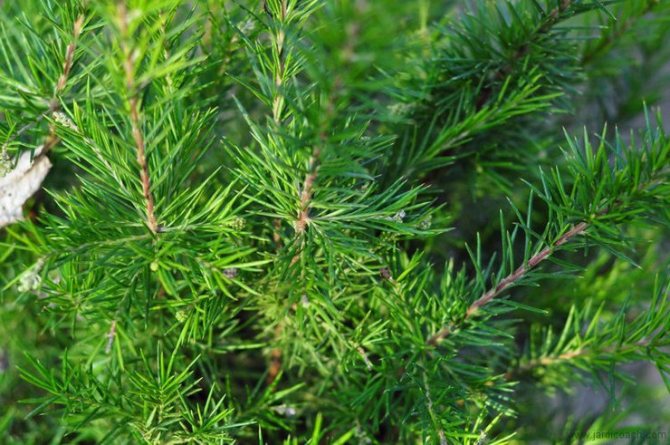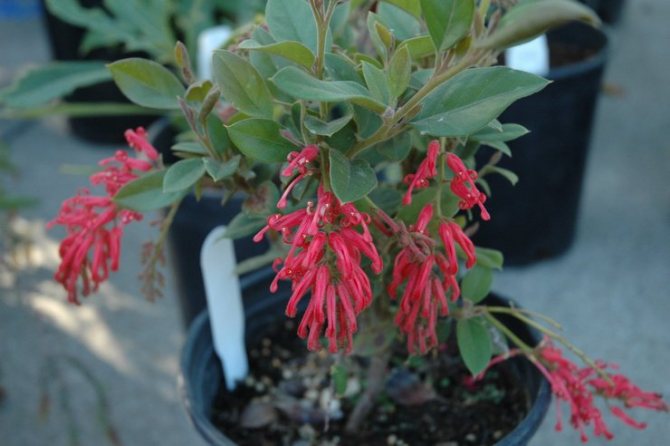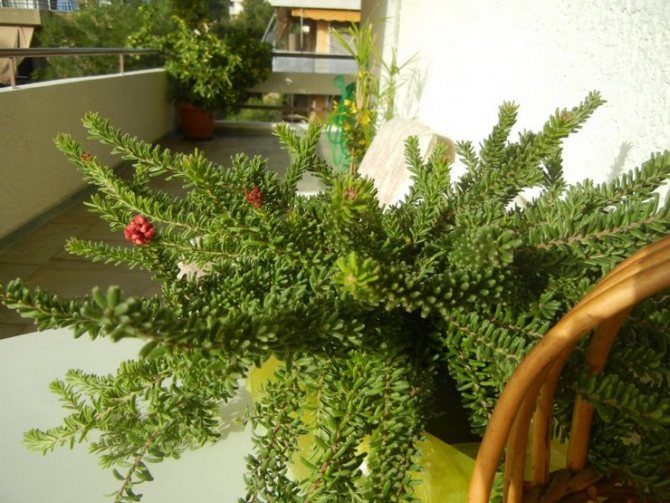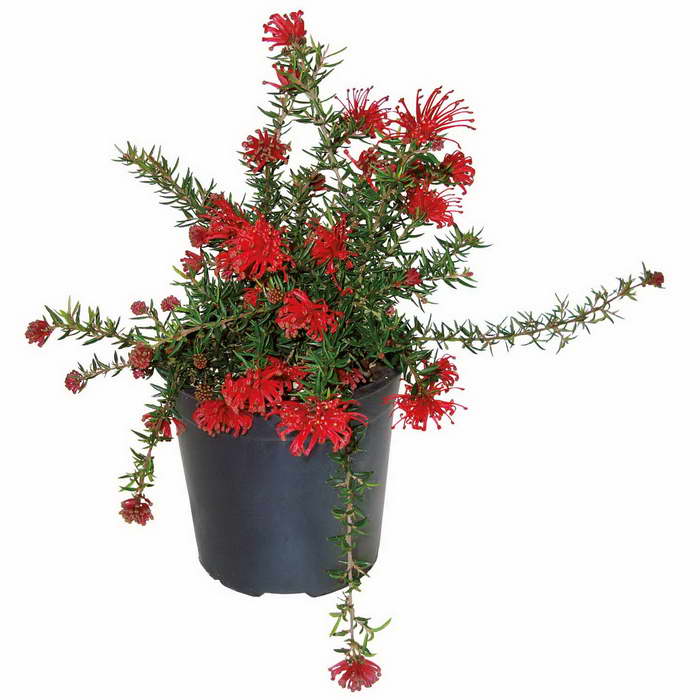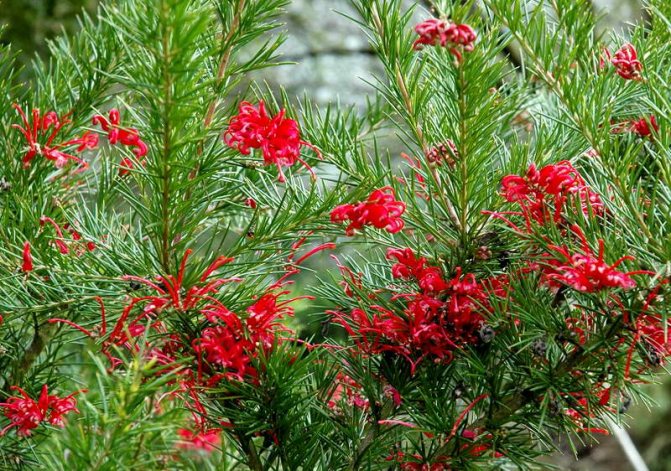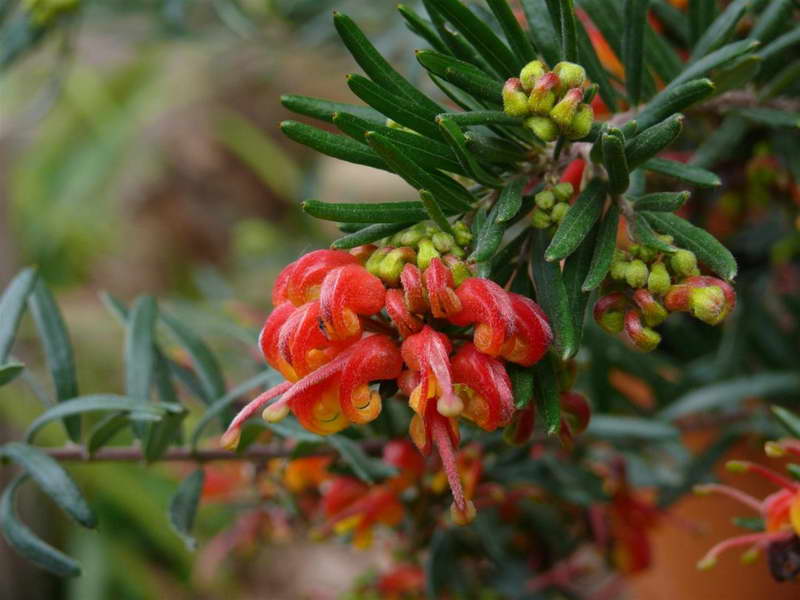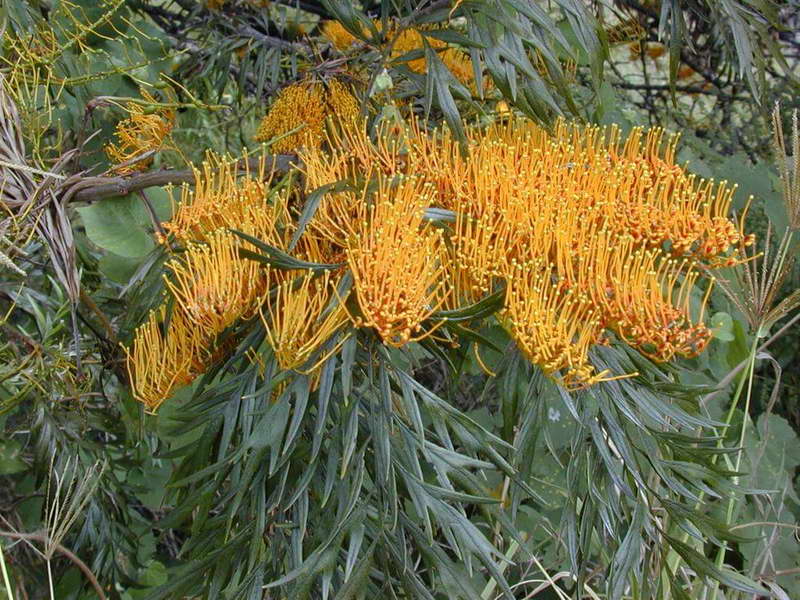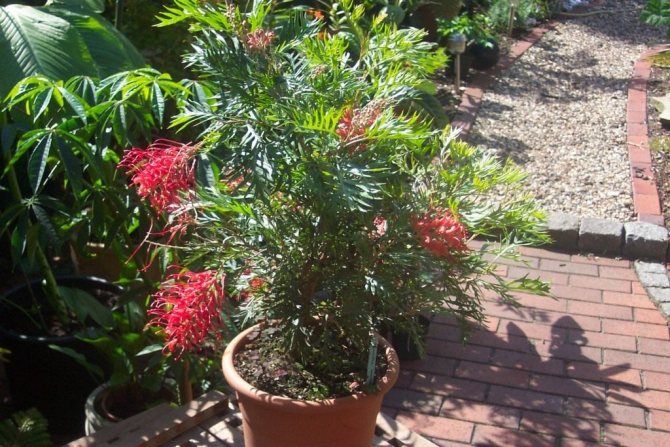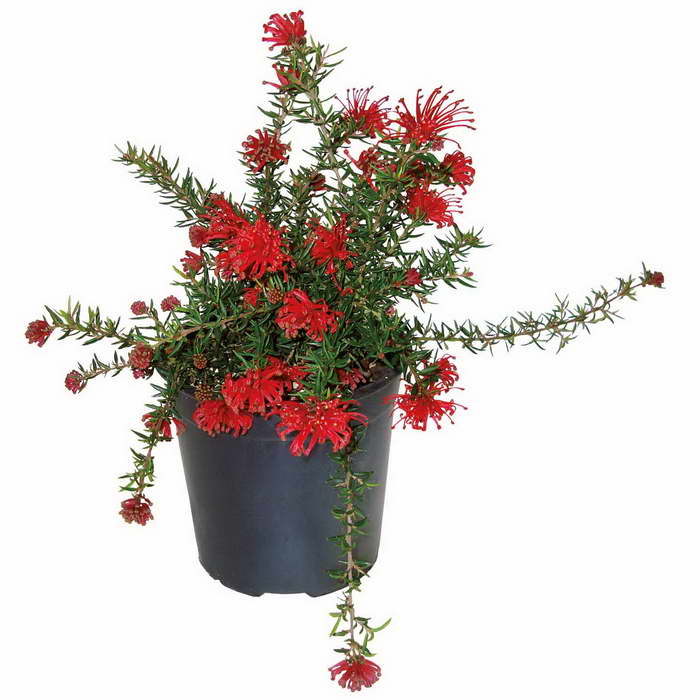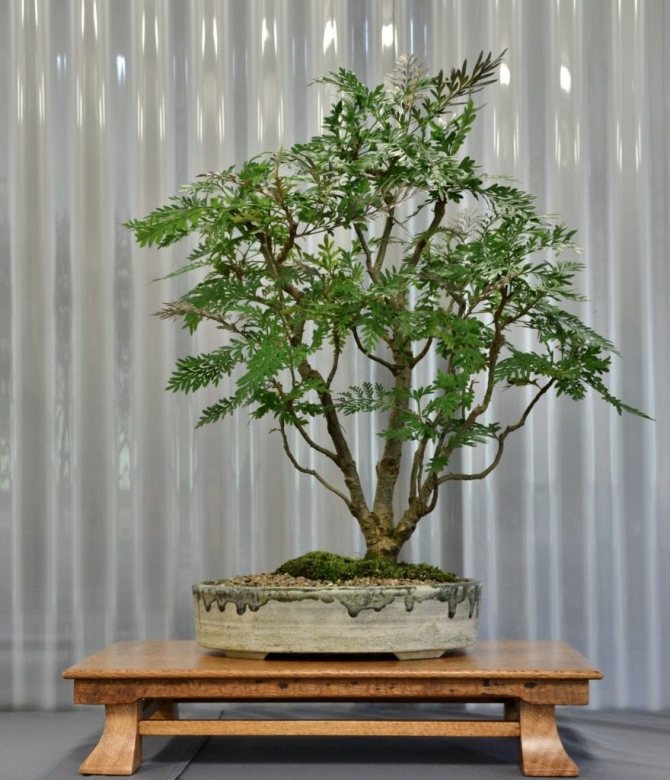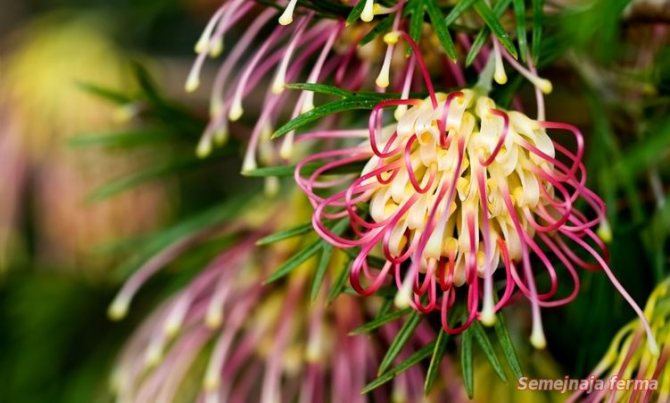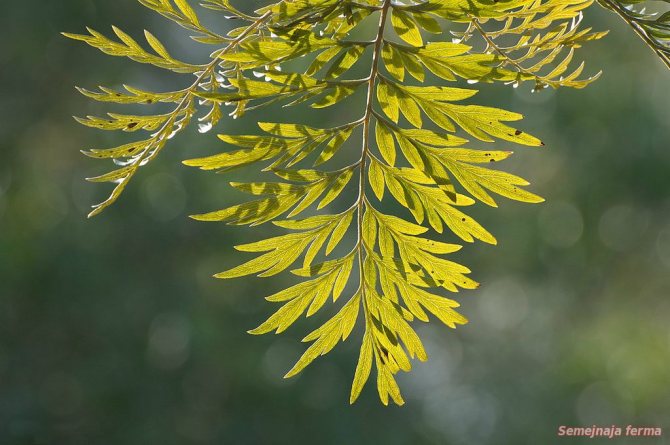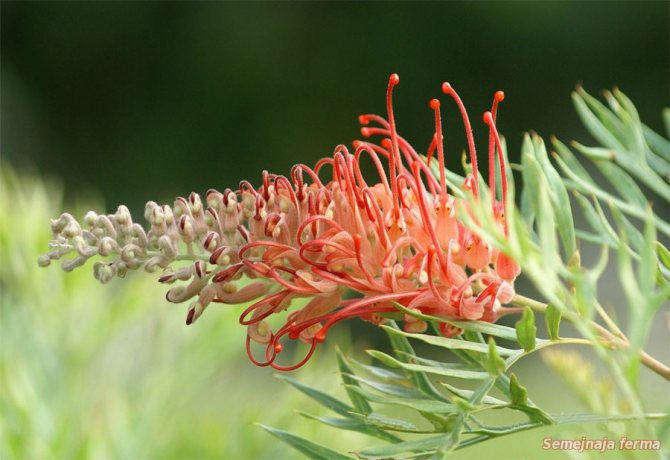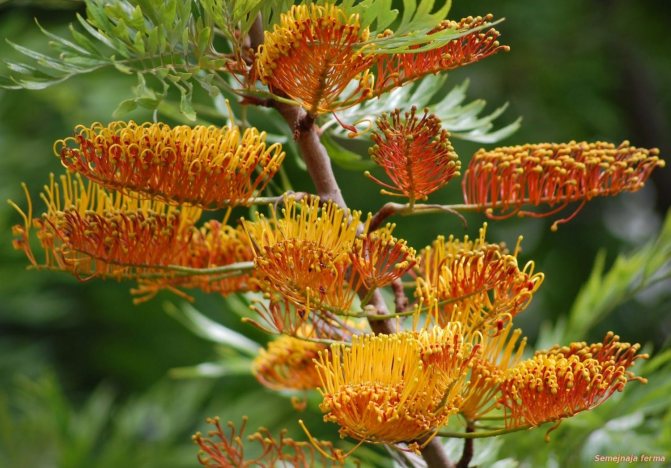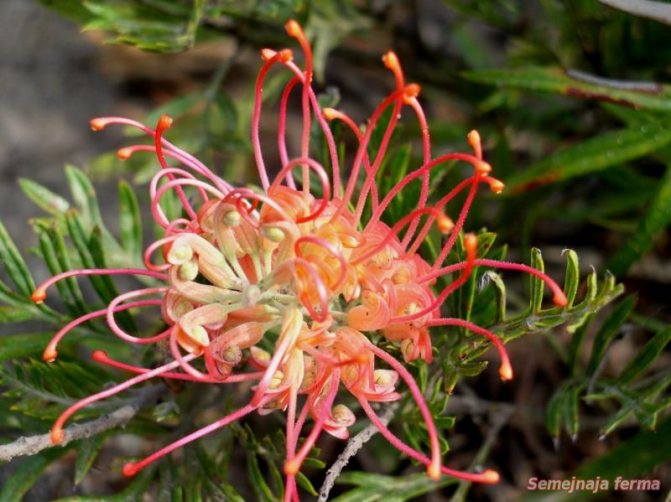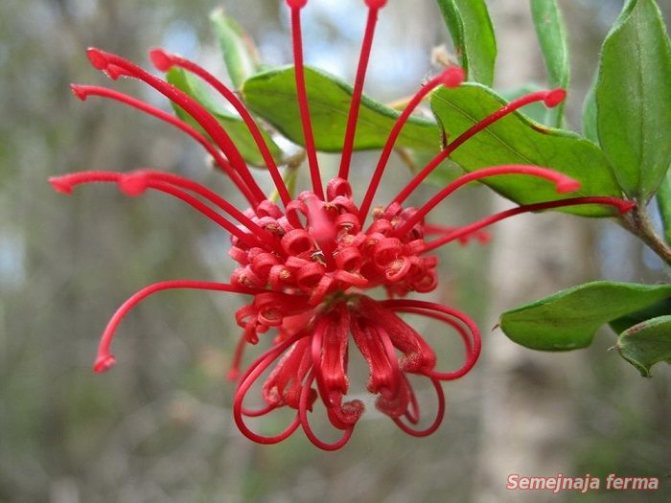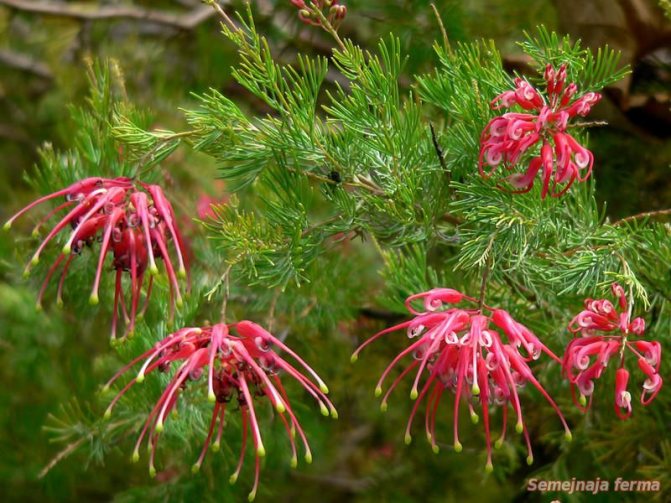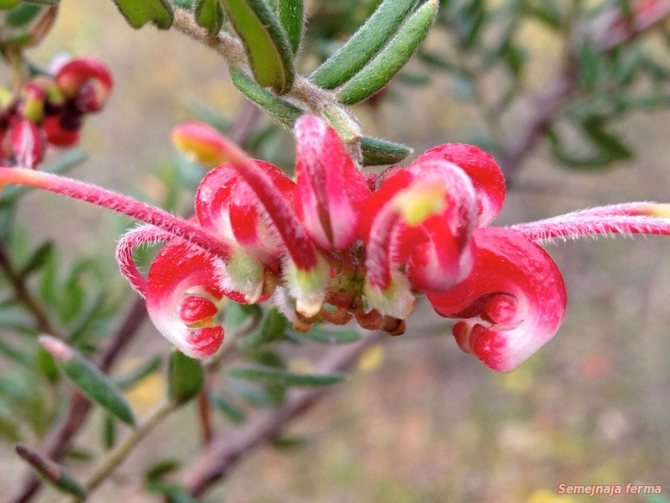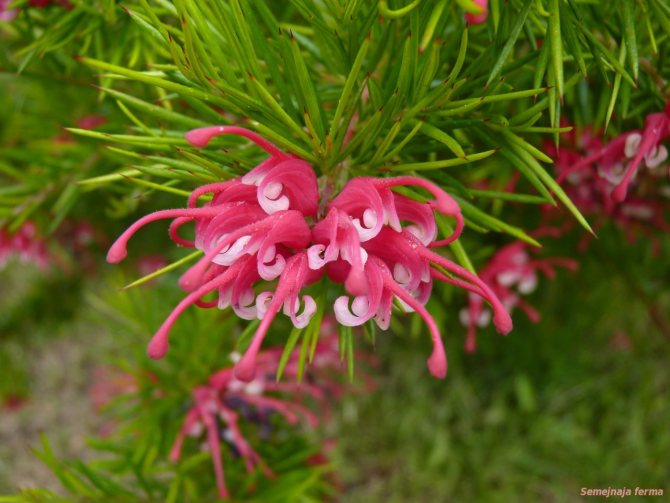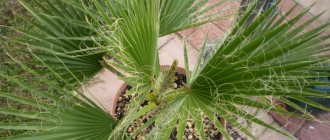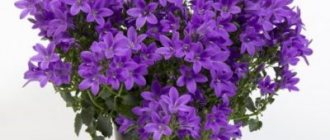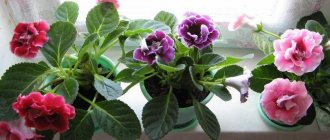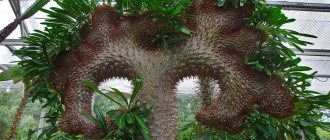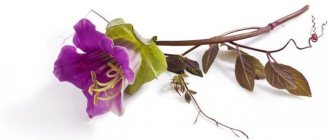The Grevillea plant belongs to the interesting and non-standard large-sized indoor plants. Despite the fact that in size it is still inferior to palm trees or some vines growing at home, grevillea will never remain unnoticed against their background. It is a large, but at the same time lush and bright indoor tree, which not only does not burden the interior, but also gives it airiness with its filigree greenery and completely exclusive and unlike flowers we are used to. In fairness, it must be said that this is not the most convenient indoor plant for breeding at home due to the requirements for cold wintering and the need for constant correction of dimensions. But the flower has its devoted admirers and, in general, is certainly worthy of attention.
Tips for growing grevillea from seeds, care
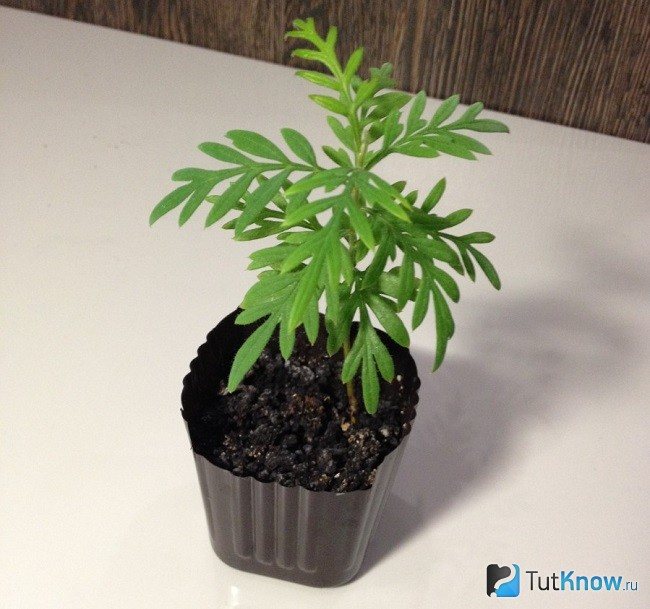
- Lighting. This green beauty loves to “bask” in bright, but diffused lighting. However, in the summer, when the plant is on the sill of a window with a southern location, it will be necessary to shade from direct sunlight. Western window sills are best suited for growing.
- Air temperature. Grevillea should always be placed next to the window, and it is desirable that the temperature readings fluctuate between 15-18 degrees, and with the arrival of the winter period, you will have to move the pot with the plant to a cool room where the temperature will be maintained at 8-10 degrees.
- Watering for Grevillea must be done very carefully. If you allow at least once that the soil in the flowerpot is flooded or too dry, then irreparable harm will be caused to the plant. Therefore, from spring to summer, the soil should always be slightly moistened and watering is moderate, however, the frequency of moistening is adjusted based on heat indicators. In winter, watering is significantly reduced.
- The humidity of the air when growing a pinnately dissected plant must be high, otherwise the tips of the leaf lobes will dry out and a spider mite may be affected. However, since the leaves of some varieties have pubescence, spraying is not the best way to reduce dryness in a room, but if there is no choice, then it is also used. Only soft water is taken for spraying, otherwise whitish stains will appear on the leaves. You can also place vessels with water and mechanical air humidifiers next to the Grevillea. It is recommended to install the pot with the plant in deep and wide containers, at the bottom of which chopped sphagnum moss, expanded clay or pebbles are laid. A small amount of water is poured there, which evaporates and will raise the humidity. The main thing is that the bottom of the flowerpot does not touch the edge of the liquid, in order to avoid rotting of the root system.
- Fertilizers. As soon as the Grevillea leaves the winter rest regime, and signs of increased growth appear, it is necessary to begin to feed the plant. This time stretches over the spring and summer months. The frequency of top dressing is once every 7-14 days. In this case, liquid preparations for indoor plants are used, which are a complete mineral complex. It is recommended to follow the instructions for diluting the fertilizer.
- Transfer and selection of soil. When the bush is still young, then changing the pot and the soil in it is required annually in the spring.The container is taken large twice in size from the previous one, but not deep. It is important that a layer of drainage material is laid on the bottom (about 2-3 cm of medium-sized expanded clay or pebbles). When the Grevillea is already large and heavy, then they are limited only to changing the top layer of the soil, adding a substrate with top dressing already introduced into it. There is evidence that the plant can be grown on hydroponic material. The substrate for transplanting is selected slightly acidic, it can be mixed independently from leafy soil, coniferous soil, peat soil, river sand with the addition of sifted brick chips (in a ratio of 1: 2: 1: 1/2).
- Pruning of Grevillea is done regularly to contain growth and compact the shrub. Pruning is well tolerated by this green beauty. This operation must be performed before the start of the activation of vegetative growth. If you do not pinch the shoots, cut the branches, then they are ugly stretched, and for decorativeness it is important that the gaps between the leaves are small.
Plant features
Grevillea is growing very quickly.
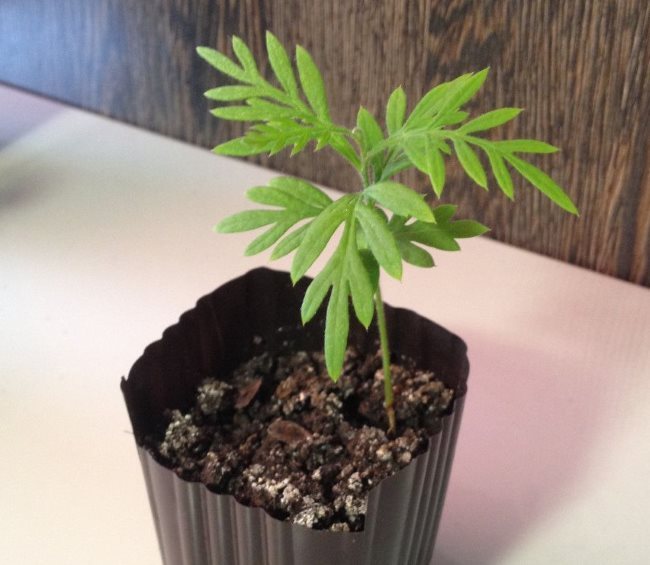

This Grevillea bush is only 2 months old.
Depending on the species, during the spring-summer period, it adds in height 30-50 cm and even more, so it needs regular pruning to stimulate the appearance of side branches. If they are not carried out, the plant will lose its decorative appearance - it will seem awkward and "naked".
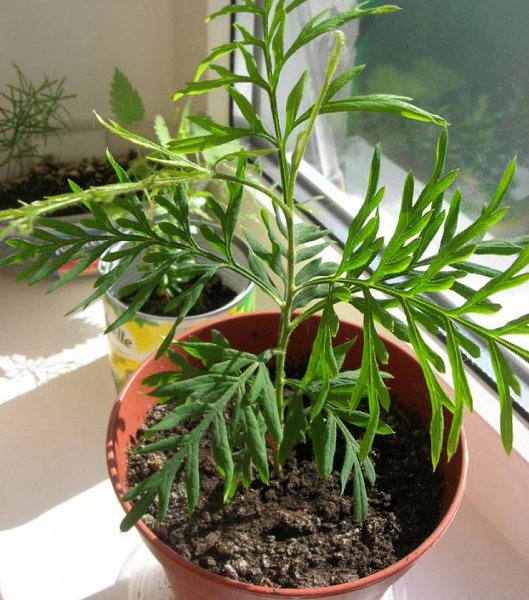

And this is already a rather large plant at the age of 4 months. The flower is grown on a window sill facing the east side of the house.
Heavy pruning is done in February or early March. Just at this time, the dormant period ends and the grevillea is actively building up its green mass. But you can pinch young shoots throughout the growing season.
By the way, due to such a high growth rate, it is a real find for those who want to master the technique. bonsai... If the cultivation and formation of one mini-tree takes an average of 7 to 15 years old, then in the case of this flower, this period will be reduced three times.
Recommendations for breeding grevillea at home
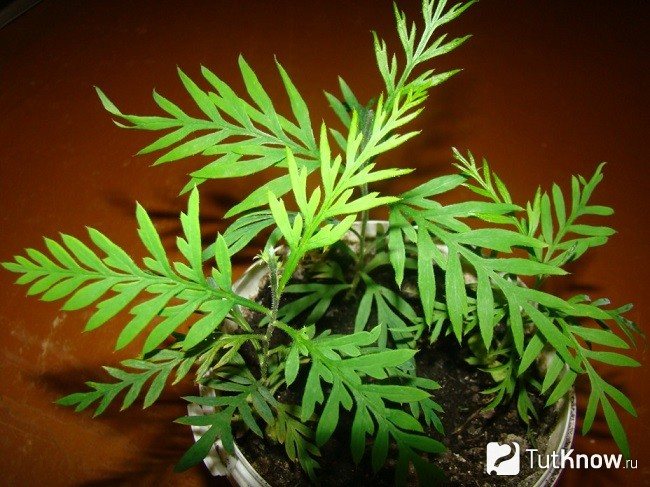

It is customary to propagate this plant by cutting and sowing seed.
For seed propagation, only fresh samples should be taken, as their germination is very short-lived. The sowing operation is carried out from January to March. A wide container is taken and filled with a mixture of peat soil and coniferous soil (equal parts). Seeds are laid evenly on the surface of the substrate and powdered with a layer of soil. Then the container is covered with glass or a plastic bag - this will create the conditions for a mini-greenhouse, with increased humidity. It is necessary not to forget to regularly ventilate the seedlings (so that the crops do not rot) and, if necessary, spray the soil from a spray bottle. As soon as the sprouts hatch, it is recommended to remove the shelter. When a pair of true leaf blades appears in the sprouts, transplantation is carried out in separate pots with selected soil for growing Grevilleas. Vases are placed in a warm place with good, but diffused lighting.
For vegetative propagation using cuttings, the material is cut at the end of the summer season. The branch should be semi-lignified and with a heel. The cut of the cutting is treated with a root formation stimulator and planted in a moistened peat-sandy substrate or plain sand. Seedlings must be wrapped in a plastic bag or placed under a glass vessel. For better rooting, it is recommended to maintain heat indicators in the region of 18-20 degrees. You also need to remember to air the seedlings. When the cuttings take root, they will have to be transplanted into separate, shallow containers with drainage at the bottom and a suitable substrate.
Diseases and pests
The main threat to all Grevilleas is spider mites.If no measures are taken for the plant to increase the humidity of the air, Grevillea grows in an almost dry climate, these pests quickly find comfortable conditions for living and reproduction.
To fight the spider mite, you should regularly, with a frequency of about 1 time per week, inspect the foliage and, at the first signs of damage, take measures to increase air humidity and spraying with insecticides.
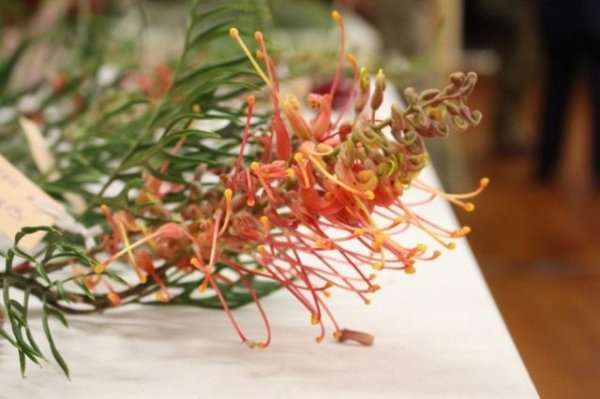

Grevillea flowers.
Diseases and pests of grevillea
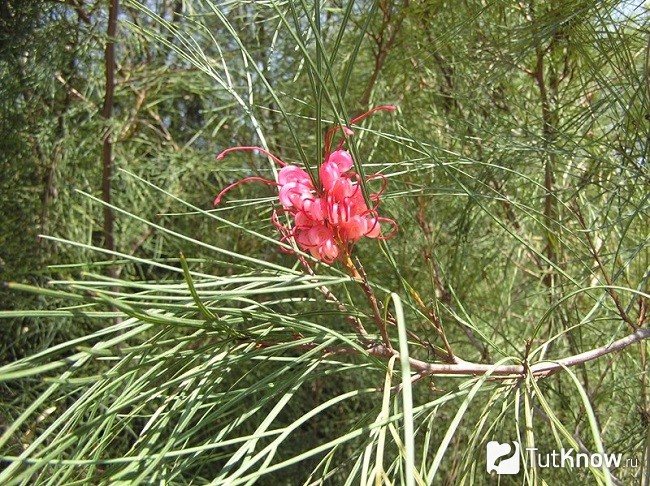

The following troubles can be distinguished when cultivating Grevillea in indoor conditions:
- if in the winter the plant was not kept in cool conditions, then the leaf plates acquire a yellow tint;
- growing in strong shade or high temperatures (especially during dormant periods) will lead to leaf shedding;
- in the case of insufficient illumination, poor feeding or in the absence of crown molding, the shoots are pulled out and the leaf plates are shredded.
If the humidity in the room where the pot with the plant is kept decreases, then there is a likelihood of being hit by a spider mite. This pest is manifested by yellowing of leaf plates, their deformation, discharge and covering of leaves and branches with a thin cobweb. To fight, it is necessary to regularly (once a week) inspect the leaves, increase the humidity in the room in any way and treat the bush with an insecticide.
Grevillea care
Watering and air humidity
Grevilleas are quite hygrophilous plants. But the rate of moisture consumption from the substrate directly depends on the growth rate of the plant and its age. The older the tree becomes, the more frequent and abundant watering it needs. Grevillea does not tolerate stagnant water, but loves medium rather than light substrate moisture. Between watering, only the top soil in the pot should be allowed to dry, and the excess water should be drained 4-5 minutes after watering.
Drying out of the soil should not be allowed not only from spring to autumn, but also in winter. True, in the cold season, watering should be reduced so that the humidity is only light, less than when the plant is in a warmer environment.
But the main parameter of irrigation for Grevillea is water quality. Only soft water can be used for this plant.
It is worth paying attention to air humidity. Grevillea leaves will be more beautiful the more humid the plant grows in. Grevillea is not afraid of typical living conditions, but if you provide her with high humidity, the attractiveness of the tree will reach a new level.
It is not necessary to install humidifiers for Grevillea: this plant is fully content with spraying. But if you can use at least wet moss pallets, you save yourself a lot of hassle. The main thing is to spray regularly, in the warm season - daily.
Top dressing for grevillea
Grevillea loves feeding. And this is easy to understand: the rapid growth of greenery requires appropriate compensation for the depletion of nutrient reserves in the soil. If the plant is taken out into the open air, then it needs to be fed weekly. In indoor mode, from March to early October, feeding should be less frequent - every 2-3 weeks. There is no need to feed Grevillea during a cool winter.
For this plant, it is better to use complex, universal fertilizers, and not mixtures for decorative deciduous crops. Indeed, despite the fact that Grevillea does not bloom indoors, it does not at all become a purely deciduous crop and for normal development it needs a balance of nutrients, and not just nitrogen.
Pruning grevillea
This Australian beauty tolerates pruning very well. Restraining growth, thickening the crown can be carried out regularly, annually, before transplanting and the beginning of active growth.Without pruning, pinching or shortening the tops of the shoots, Grevillea stretches out, large gaps appear between the leaves.
Transplant and substrate
It is better to transplant Grevillea if necessary, and not on schedule. But since the plant grows quickly, it usually changes its substrate and capacity annually. If you have an old Grevillea and don't replant it every year, be sure to remove the topsoil and replace it with fresh one. But during the procedure, be careful not to damage the roots of the plant. It is best to transplant at standard times, after the start of growth in late February and early March.
The soil mixture for grevillea should also be specific. These beauties prefer to grow in clay in texture, but loose, containing a high percentage of humus and certainly acidic substrates.
For grevillea, containers should be selected very carefully. This plant is grown in medium-sized pots, because Grevillea does not like too much free soil, developing in such conditions to the detriment of the attractiveness of greenery.
Common problems in growing Grevillea
- shedding leaves in strong shade or in hot conditions (especially during wintering);
- stretching shoots and shrinking leaves with poor lighting, insufficient feeding or lack of trimmings.
Popular types of grevillea in indoor floriculture
In natural conditions, there are shrubs of this type, and their height does not exceed 1 meter. But the trees grow and can reach 35 meters in height. Indoor grevillea does not grow higher than 2 meters, it is used to decorate light and cool rooms.
In nature, Grevillea blooms, but this never happens in a room. But even without flowering, the plant is very beautiful, it is distinguished by lace leaves up to 30 cm long, which are covered from below with a silvery fluff border. Outwardly, these leaves are very much like a fern, although they look more graceful.
At home, you can grow the following types of grevillea:
- Green Island is an evergreen plant with a medium growth rate. It grows up to 2 m in height, and needs regular pruning to form the crown. Well suited for apartments and private houses, easily tolerates cool temperatures up to +6 ° C.
- Grevillea is powerful - this is already a tree that grows up to 3.5 m in height. The leaves of such a plant are very dense, dark green, and from the bottom they are covered with a yellowish edge. In nature, the powerful Grevillea blooms with small yellow flowers collected in a brush.
- Rosemary Grevillea is a shrub and is native to Australia. The leaves of rosemary grevillea reach 10 cm, and their height is 1.8 meters.
General description with photo
Grevillea is an exotic flower from the Protein family, in which it is its largest representative. It grows naturally mainly in Australia, but some varieties are found in Tasmania, Malaysia and some other Pacific islands. It is now ubiquitously cultivated far beyond the borders of this region practically all over the world. The most widespread in culture is the powerful Grevillea variety, which is an evergreen decorative deciduous tree, less often a shrub. The leaf plate of the plant is of a simple pinnate type, has a double or triple dissected openwork elliptical shape. Leaves up to 30 cm, notable for their silky pubescence, thanks to which the tree received its second name in its homeland - silk oak.
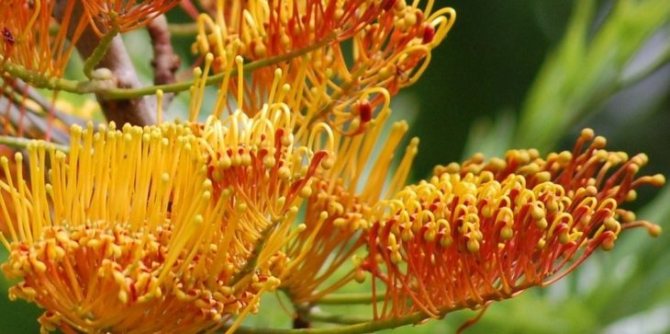

Abnormal racemose apical inflorescences, with filiform petals-stamens. Their color can be different, but always bright and interesting. After flowering, a leathery, in more rare cases, woody leaflet fruit of a flat curved shape is formed. The wing of the leaflet is narrow or absent altogether. At home, Grevillea can grow up to 2 meters in height, and in nature it can reach 30 meters.
At home, grevillea usually does not bloom, since this requires compliance with rather difficult conditions. It is usually used as a vegetable exotic accent in large and cool rooms, as well as in winter greenhouses.
How to grow grevillea from seeds?
Growing from seeds begins at the end of winter or in the first days of spring, the shrub does not like the heat and grows better at this time. Sow the seeds into soil mixed in the following proportions: 2 parts sand, 2 parts humus and 1 part turf. And the soil for transplanting seedlings should be more acidic, it consists of leaf, coniferous, peat soil and sand.
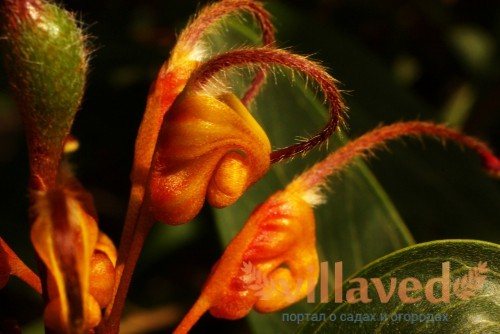

Grevillea marmalade
Germinating Grevillea is no different from growing our simple flowers. Just prepare the soil, carefully place the seeds in it, cover them with earth, spray with a spray bottle. That's it, now you can cover future seedlings with glass or plastic!
Place the box with seedlings in a room with a temperature not exceeding 17-20 ° C, regularly ventilate it by removing the glass. The fact is that young seedlings need fresh air.
The growth of this shrub is uneven, so the dive is carried out as the seedlings grow. Throw out the top 2 leaves? Then you need to transplant into a separate pot. And after 3-4 years, the shrub will easily rest its crown against the ceiling.
Young seedlings are transplanted every spring, and adults - after a year.
Grevillea - photo, care, growing from seeds
Botanical name: Grevillea.
The Grevillea plant is a family. Proteanaceae.
Origin. Australia.
Description. An evergreen tree with large, alternate, often pubescent leaves up to 40 cm long, similar to ferns, consisting of numerous leaves. Leaf shades range from light to dark green, sometimes with a bluish tinge. The flowers are white, red, yellow or orange and appear at the tops of the branches, in racemose inflorescences. Large straight or slightly curved pistils make Grevillea flowers look like splayed brushes.
Grevillea large or robusta - Grevillea robusta
In its natural habitat, it is a tall, fast-growing, evergreen tree up to 40 m with an elongated crown. The plant has very attractive, complex, dissected leaves. The surface of the leaf plates is glossy, green, the underside is often painted in a lighter shade. During the flowering period, the plant profusely forms oblong inflorescences with many petalless flowers with long, orange-red stamens.
An interesting feature of the plant is that it loses some of its leaves before flowering.
Grevillea woolly - Grevillea lanigera
Extremely spectacular yet compact shrubs with a dense, spreading crown formed by abundantly branched, long shoots. The leaves are narrow, linear, reminiscent of needles, reach a length of 1 - 3 cm, are colored green or bluish-green, densely cover the stems. During the flowering period, the plant adorns itself with small apical inflorescences consisting of red, pink or crimson flowers
Grevillea Banks - Grevillea banksii
A tall, spreading flowering shrub or a short, evergreen tree up to 7 m with thin, graceful twigs. Leaves are complex - they consist of many linear, green segments. In spring and summer, cylindrical inflorescences with many pink, red, less often white or cream flowers with long, curved and fluffy stamens appear on the tops of the shoots.
Grevillea rosemary - Grevillea rosmarinifolia
Small evergreen shrubs with a rounded, lush crown up to 2 m high.Dark green or bluish green, needle-like leaves resembling needles have a glossy surface and abundantly cover the stems of plants, reaching a length of 1 - 4 cm.Bright pink or creamy flowers appear on the plant in spring or summer in small apical inflorescences.
Grevillea juniper - Grevillea juniperina
Spectacular shrub with thin, long, horizontal branches. The leaves are light green, glossy, needle-like. This variety has a very diverse flower color - they can be white, cream, yellow, orange, pink or red.
Height. In natural conditions, it can reach a height of 30 m. In culture, when grown as a houseplant, the height is 45 - 180 cm and is well regulated by pruning.
Plant care at home
Comfortable temperature for keeping
The shrub is not capricious and tolerates heat well in summer. But before the start of the heating season, the flowerpot with the plant can be taken out on the veranda without heating with a temperature of at least 6 ° C. In winter, he just needs low temperatures. Frequent ventilation of the room has a beneficial effect on the growth of the shrub.
Lighting and the importance of fresh air
Suitable lighting for Grevillea is diffused light, in the season - muted sunlight. Never expose shrubs to direct light, as this can destroy them.
The plant responds well to air humidity. At low - it gets sick, and at high - it grows well. If the humidity in the room where the flower is kept is low, then it is worth spraying the shrub with a spray bottle.
Watering
In the spring and summer, the shrub is watered as the top layer of the soil dries out. With the arrival of autumn, watering is reduced to a minimum so as to prevent the soil from completely drying out. Only settled water of the same temperature as the flower is used.
Top dressing, pruning and other care at home
From early March to mid-September, Grevillea enters an active growth phase, and it needs additional feeding. Mineral fertilizers are used once every 2 weeks, but it is better to refuse organic matter.
The shrub grows very quickly, so it needs timely pruning. Pruning is important not only for proper crown formation, but also for slowing growth. Without it, the plant will reach the ceiling in 1-3 years, and at this moment it will be too late to correct something.
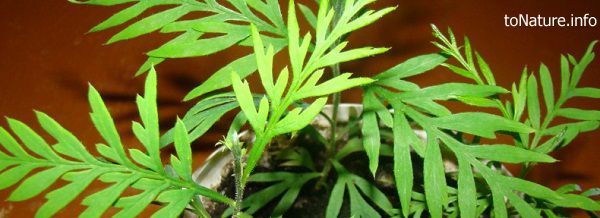

After repairing and rearranging the furniture, I began to feel that the room began to look somehow official, there was no life, soul, or comfort in it. After some thought, it became clear: a green corner with a large tree in the center of the composition can solve the problem. After going through many options, I decided to stop at Grevillea. The main argument in favor of this plant was that it is not only very beautiful, but also grows quickly and tolerates pruning and shaping well.
At the very beginning, I made a mistake: in order not to engage in the acquisition and germination of seeds, I took cuttings from friends. Experts warned that this method rarely gives results, only it seemed to me that with the right approach, at least one process would survive. Everything seemed to be done correctly, and the time was right, and I processed the cuts, but none of the three branches took root.
I had to buy seeds. I do not know how to determine their freshness, but I know that old grains do not germinate, it remains to rely on the seller's word of honor. I bought wide pots and soil for planting, poured sand with an admixture of small pebbles for drainage on the bottom of the vessels, and filled the container with soil. I sprinkled the seeds laid out on the soil with earth, watered them, covered them with glass and hid them from the sun's rays.
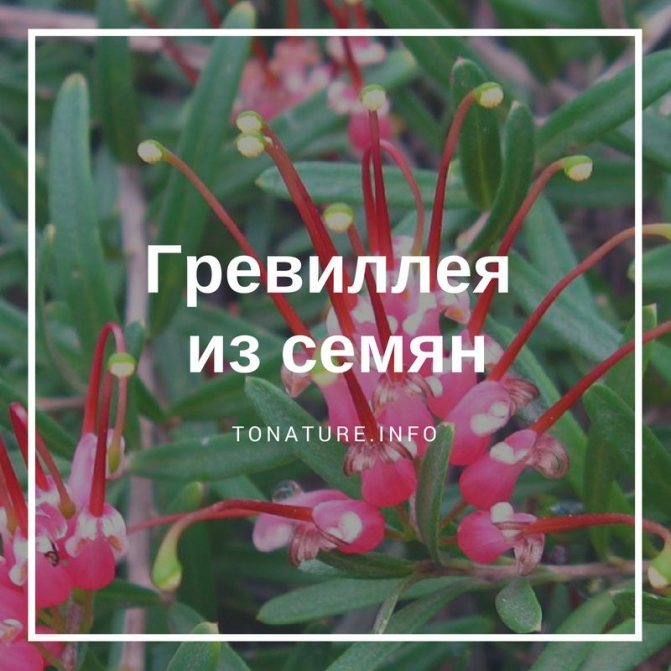

Despite the fact that Grevillea is a subtropical plant, she does not like extreme heat and burning sun, in summer she is comfortable at 20 ○. In such conditions, my pots with seeds stood, and 2-3 times a week I removed the glass for a few minutes to ventilate and see if the soil was dry.The seller did not deceive, all the grains sprouted, and I took off the glass - let them now develop in the fresh air. Since one tree was required, and the planting material purchased with a stock did not fail, some friends received exotic plants as a gift.
When the pet got a little stronger, on warm days I took it out to the balcony, fortunately, it is located on the west side of the house and is illuminated only by the cool setting sun. Grevillea is demanding on soil moisture, even a single drying out of the roots can lead to the death of the plant, but excessive moisture can also destroy it. The signal that it was time to water the tree was for me the drying up of the top layer of the soil. I watered abundantly, until the water came out to the pan under the pot, and a good drainage layer protected from the excess liquid.
The onset of winter caused a lot of excitement in me: at this time, it is recommended to keep the Grevillea at a temperature of about 10 ○, but where can you find this in a city apartment? In my opinion, the coolest place I had was near the window, put the pot there, watered less often and not as abundantly as in summer, and sprayed it daily. My beauty overwintered, it seems, did not even notice that the conditions were not very suitable.
In the spring, I transplanted the tree into a wooden tub, at first it seemed that the capacity was too large, but by the fall it became clear that the roots were developing very quickly, and the dishes needed to be chosen with a large margin. I buy land only in specialized stores, because with the soil accumulated outside the city or bought on the market, you can bring in viruses and pests. For the summer I took out the Grevillea to the dacha, put it on the street in the shade of the crown of a large tree. Twice a month I fed her with complex fertilizer, and on hot dry days I sprayed the leaves. By the fall, the plant was unrecognizable, it stretched out almost 30 cm, dismissed large carved leaves, covered with a small fluff from below. Perhaps that is why grevillea is also called silk oak.
Every spring I replant the tree and it grows very fast. If not for the constant scraps, the ceiling of my apartment would have seemed too low to him. This procedure is needed not only to reduce the height: with proper formation, the branches develop well. So that the cuts do not spoil the appearance of the Grevillea, I make them obliquely, soon the traces of the operation become invisible.
Periodically, I examine all the leaves to see if there are any grayish punctures of the spider mite, I also look at the lower side, this is where the whitefly with its larvae can settle. So far, no one has attacked the tree, it is healthy, but I have prepared preparations for pest control.
In the brightest corner of the room, my beautiful grevillea grows. Admiring her, I am upset with only one thing: at home, these plants bloom very rarely. So far, neither I nor my friends have such a miracle happened, we can only hope that someday she will want to please the owners and release a huge orange bunch of magnificent flowers.
Well, now the story of growing grevillea from seeds.
Day 1.I bought these seeds. The seeds themselves are quite interesting to look at, so flat and fragile.
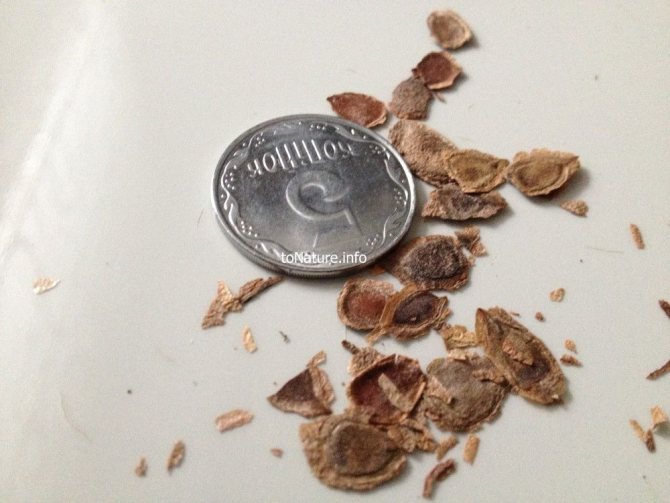

Day 21. It is already clear that the seeds did not fail, it sprouted!
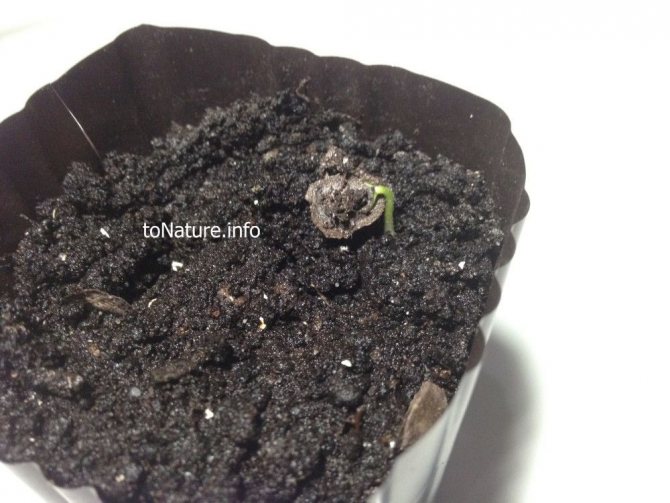

Day 30. At this stage, the plant looks like this.
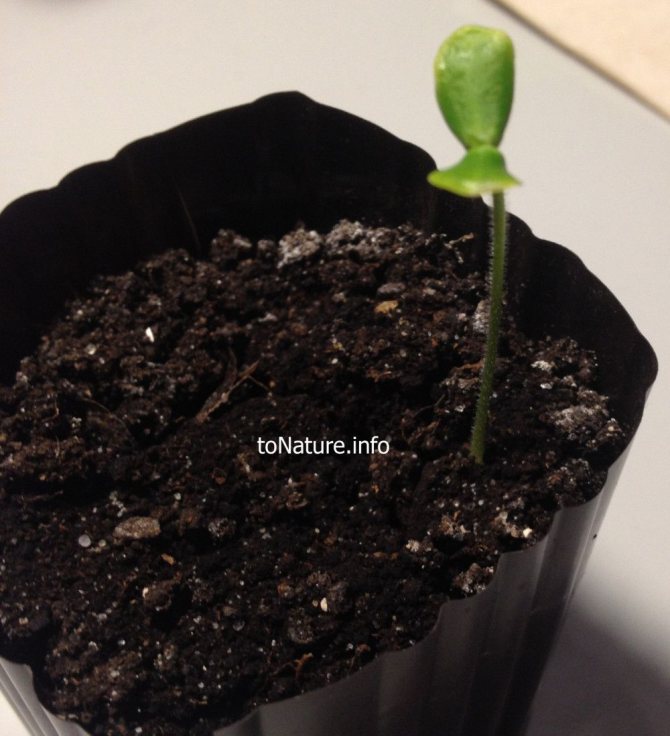

Grevillea from seed 2 months:Here it is noticeable that the plant has slightly recovered, I think this was due to insufficient watering. I no longer allowed the earthen lump to be completely dry.
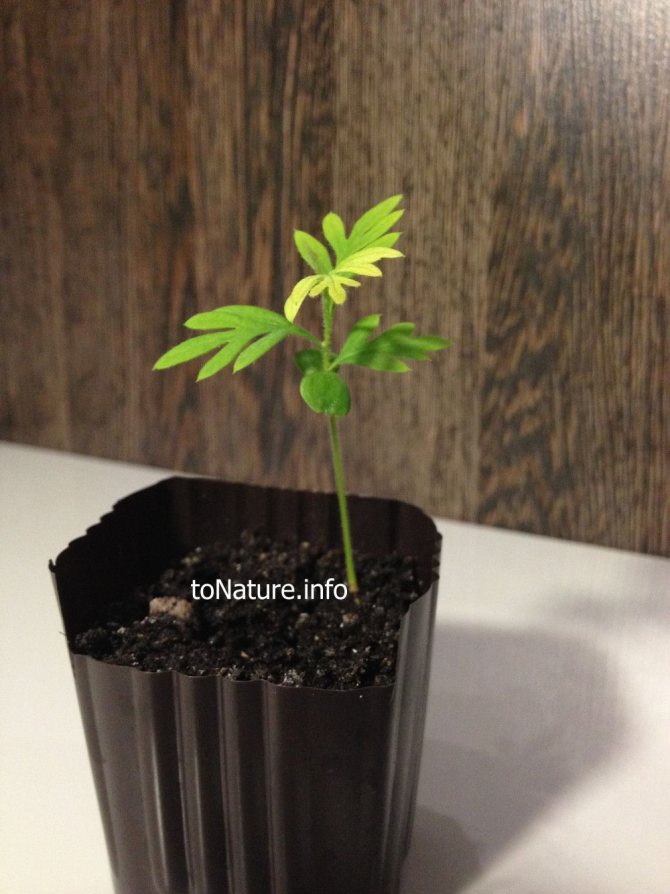

Grevillea from seeds 3 months:I guess I was right. The plant no longer turned yellow and did not weaken.
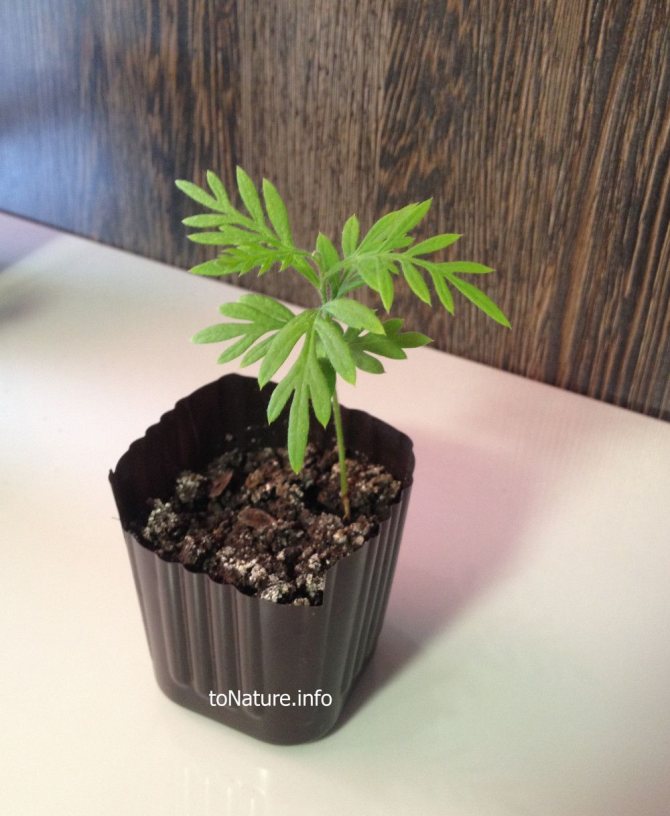

Grevillea: 4 months... Notable development. What I liked is that the plant feels good even on site with a slight draft.
5 months to my tree.
Half a year has passed since I planted the seeds. The plant wintered well, summer is ahead and everything will be fine :)
and here is a video of the whole process:
Please rate the material you have read :)
[ratings]
Description
The genus of this plant has about 200 species, radically different from each other. At home, representatives of the culture can be in the form of large trees with a trunk height of up to 35 m or be creeping shrubs no higher than 50 cm.
As a houseplant, Grevillea is cultivated due to its thin, feathery leaves, which reach 30 cm in length.
It is almost impossible to achieve flowering with indoor cultivation and maintenance. The plant needs high humidity and does not tolerate the winter season with its artificial heating. However, if all the conditions are met, the shrub will delight you with abundant brushes of different shades with many tubular flowers, twisting perianths and long columns.
Most often, grevillea is placed in cool and bright rooms, in which it is given the main role (without being adjacent to other indoor flowers). With proper care, the plant can reach a height of 2 m.
The main varieties with a photo
In their natural habitat, on the Australian continent, there are more than 250 species of Grevillea, of which only 17 varieties can be found outside the region. Some of them are suitable for growing as indoor flowers.
Alpine grevillea
A relatively undersized variety, which has a shrub shape and usually does not exceed 1 m. Shoots are heavily pubescent with a delicate silky felt, densely leafy. Thin leaves have a blunt end and slightly curled edges; on the reverse side they also have a silky tomentose pubescence. Inflorescences are pink-red at the base with a transition to yellow, small in size.
Greville Banks
Tall, tree-like shrub with branched, densely pubescent shoots. Leaves up to 20 cm, almost smooth, narrow lanceolate. The color of racemose inflorescences is bright red, saturated, with yellow tips of filamentous petals.
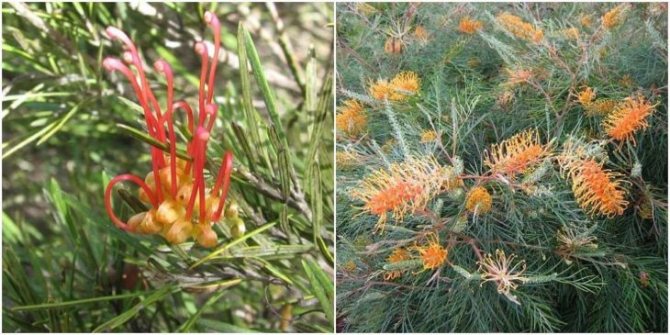

Grevillea is powerful
A very tall tree in the environment of natural growth, reaching 25-30 m. When grown at home, its size is much more modest, but in an apartment it is still a large-sized plant that requires molding. The branches are either naked or with short pubescence, gray in color. The leaves are elongated, up to 2 cm, with large denticles at the edges, twice pinnate, covered with pile only on the underside. The clusters of inflorescences are colored bright orange. In indoor conditions, it blooms extremely rarely, requires contrasting seasonal growing conditions.
Grevillea woolly
A very variable variety, which is more often a shrub, but in a certain habitat it takes on a tree-like form. As a houseplant, woolly grevillea of low varieties is cultivated, not exceeding 1.5 m, and sometimes growing only up to 30 cm. The fleecy leaves are commensurate with the overall dimensions of the plant, and have a characteristic narrow shape. Outwardly, the tree resembles a herringbone. Blossoming in red or pink tones with the presence of yellow or cream color, the shape of the inflorescence is arachnid. In nature, it blooms in winter or early spring.
On the basis of woolly grevillea, which has a high predisposition to interspecific hybridization, interesting cultivars have now been bred, among which two especially noteworthy ones should be noted.
- Rod Salento. It looks very much like a fir or a spruce tree we are used to. In Europe it is commonly known as the Christmas tree. The desired conical shape is achieved by tying branches to the supports, on which bright pink, spectacular curly flowers bloom in winter.
- Mount Tamborita (has several more names). A very compact bush in height, no more than 40 cm, with a span of up to 2 m in width. The shape of the plant is variable, usually they are engaged in the formation of interesting compositions in nurseries. The arrangement of the leaves is spiral, the shoots are densely leafy due to the slow growth of the main trunk. The flowers resemble spider legs, they have a raspberry-pink color.
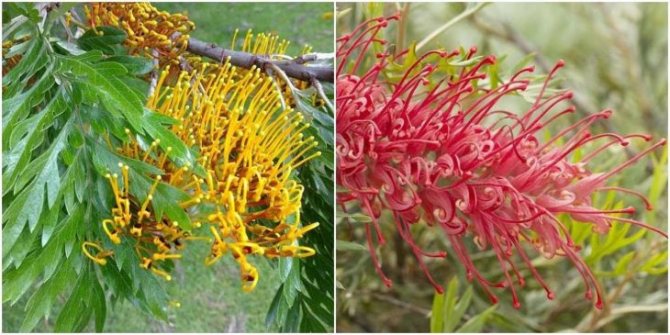

Home care
Grevillea loves cool conditions and high humidity. The plant pot should be placed in a well-lit room. In no case should direct sunlight be allowed, especially in the spring and summer period.
In the warm season, indoor trees are taken outside and placed in places with diffused light, excluding drafts or strong gusts of wind.
During the spring and summer months, the Grevilleas provide a temperature regime within the range of + 19 ... + 24 ° С. From late autumn and throughout the winter, the plant should be placed in a room with a temperature not higher than + 12 ° C.
Grooming Grevillea is easy. The main thing is to water on time, avoiding stagnation of moisture and strong drying out of the soil. The plant needs regular spraying to create a humid climate in Australian forests.
To form the crown, it is necessary to regularly correct its shape by cutting off the protruding branches. If pruning is not carried out, the plant begins to stretch intensively and can grow to a large size.
Priming
For planting, you can purchase a special acidic soil used for growing heather plants. To prepare the soil yourself, you need to take 2 parts of coniferous, 1 part of leaf and 2 parts of peat land, dilute with coarse sand and perlite.
Like all indoor plants, the Grevillea needs to provide drainage by covering the bottom of the pot with expanded clay or medium-sized stones.
Transfer
Every spring, the flower is transplanted into a not very deep pot slightly larger than the previous one. Pre-prepared soil is used. After the procedure, the plant needs to be observed for some time for diseases.
Reproduction
Propagated by Grevillea by planting seeds or cuttings. Growing from seed occurs in late winter or early spring. The soil for planting is prepared from leafy, turfy, humus soil and sand in a ratio of 1: 0.5: 0.5: 1, it is poured into small pots and the seeds are slightly deepened. To maintain optimal temperature and humidity, the container is covered with glass or a plastic bag.
Seedlings may appear unevenly. The transplant of the emerged seedlings occurs only after the second full-fledged leaf has appeared. Sprouts are planted in separate pots or in 1 box at a distance of 3 cm from each other.
Keep seedlings in a sufficiently lit place to ensure proper watering. If the picking was carried out in a common box, after the plants reach a sufficient size, they are seated one at a time.
For propagation by shoots in August, a half-ripe stalk is cut from a flower and placed in moistened sand. After the twig takes root and continues to grow, it is planted in a 7 cm diameter pot with an acidic substrate.
Fertilization and feeding
From early spring to mid-autumn, Grevillea has a period of intense growth, so it needs regular feeding. In this case, complex fertilizers are used for deciduous indoor plants, which must be applied once every 2 weeks.
In the autumn-winter period, it is not necessary to fertilize the soil. The main thing is to provide the flower with sufficient lighting and a low temperature, since this period is a dormant time.
Growing conditions
All types of grevillea are characterized by intensive growth, which has to be contained within the apartment. If you do it correctly and create comfortable conditions, the plant rapidly increases not only its dimensions, but also its internal volume, which makes it more and more attractive. But caring for a Grevillea falls into the category of increased complexity due to the fact that its needs go against the typical conditions of room maintenance.
Watering and humidity
The irrigation schedule follows the usual schedule for crops that have a dormant winter period. It should be regular throughout the growing season and is produced as the top soil layer dries out.From the beginning of autumn, they begin to limit it, and in winter the only purpose of moisture is to maintain the viability of the plant. Grevillea does not like waterlogging, but at the same time it needs high air humidity for the aboveground part. As usual, water trays, humidifiers, sprays, aquariums, etc. can be used to maintain the desired level. You cannot put the pot upside down in the water!
It is easier to regulate soil moisture in a small container, and in part, therefore, it is not recommended to use large tubs under a heating plant.
Light mode
There is a lot of controversy about this point of care for the Australian exotic. The best solution would be to ask the seller of the seedling about the conditions for keeping grevillea before buying. As a rule, these conditions are ideal for a given instance. The plant has a good natural adaptation for partially illuminated locations, although it is light-loving by nature. And yet you cannot push a tree into the shade. A sufficiently bright diffused light will be a good solution for successful cultivation. And, of course, each instance needs to be watched to understand how to adjust the conditions. A signal about poor lighting will be a change in the color of the foliage. If it is noticed that a bluish tint has appeared on it or the brightness of the colors has faded, it is urgently (but gradually!) To change the location to a lighter one. In a critical case, the foliage will begin to fall off.
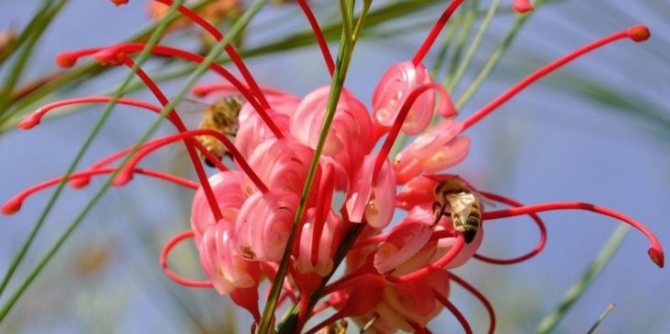

Temperature regime
This is one of the key care points that many amateur flower growers stumble over. Grevillea is not a thermophilic crop. Even in the summer season, she prefers cool rooms and already at + 23C begins to feel unwell. With the onset of the cold season, even such conditions become hot for it, and the culture feels best in winter in the temperature range of + 5 ... + 10C. As much as possible, this segment can be corrected up to + 8 ... + 15С. From here it becomes clear that in an ordinary apartment in winter the grevillea will suffer until the foliage is completely dumped.
When choosing where to put the plant, you need to choose from the coldest rooms - the entrance hall, staircase, unheated veranda, etc. Alas, there are often no such premises in the house. Loggia for this purpose is not suitable due to negative temperatures in frosty winter. Carrying the tree back and forth is also highly discouraged.
In addition to temperature indicators, the access of fresh air is also important for the plant. It will tolerate a draft better than the stagnant stuffy air of a room.
Top dressing
The culture is very responsive to feeding, and this is quite logical, given the intensity of growth, which depletes the substrate and requires compensation of nutrients. When grown outdoors, you can apply top dressing every week. With room maintenance, it is enough to do this once every 2-3 weeks, and only during the active growing season. In winter, the plant does not need feeding. Of the fertilizers, it is better to give preference to universal complexes, and not to more specific compositions for decorative deciduous and flower crops. The fact is that, on the one hand, Grevillea usually does not bloom at home, but on the other, it does not become a purely decorative deciduous plant from this. Therefore, the composition of nutritional complexes should not be skewed either towards nitrogen or towards other useful elements.
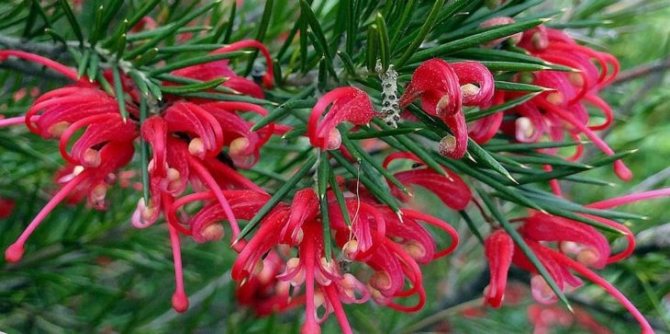

Soil mixture
The soil structure for grevillea is very specific and is close to the requirements for bonsai. It is a clayey soil, which, nevertheless, is quite loose and permeable. It should contain a significant percentage of humus at high pH values (acidic reaction). It is not easy to compose it yourself, so you should pay attention to ready-made substrates for bonsai. They are sold either in specialized stores or from manufacturers with a wide range of soil formulations on offer.
As a last resort, you can try and prepare the soil mixture yourself.For this, coniferous soil is taken, 2 times less leafy land and high peat and 4 times less sand are added to it. Fine-grained brick chips are added to the resulting mixture.
Grevillea does not like large planting containers, loses its splendor and begins to go into long shoots.
Dormant period
The plant has a pronounced period of slow vegetation, requiring a complete correction of all agricultural techniques. Specific requirements are described separately for each item.
Trimming, forming
Pruning is needed to hold back the growth of branches and awaken dormant buds to form a lush and attractive crown. Usually pruning is done in the spring.
Transfer
Up to 3 years of age, the transplant should be annual, then it is reduced to once every 2 years. Accordingly, adults who have reached their maximum size are transplanted rarely and only when necessary (for example, rotting tubs). If the bush is not transplanted in the current year, it is necessary to update the top layer of the substrate as far as possible. It develops poorly in the capacity "for growth".
General information
The Grevillea plant is grown as evergreen shrubs and trees. The leaves of this plant are simple, alternate or elliptical in shape. Flowers are bisexual with different colors, which are collected in a brush.
When grown at home, the Grevillea plant can grow up to 2 meters in height. In culture, this species is grown only because of its thin feathery leaves, which reach up to 30 centimeters in length. Usually, the flowering period does not begin in indoor conditions, due to the fact that the plant is quite difficult to care for, since it needs high humidity and does not tolerate warm winter periods. Most often, this plant is used as a tapeworm in cool and bright rooms.
Flower types
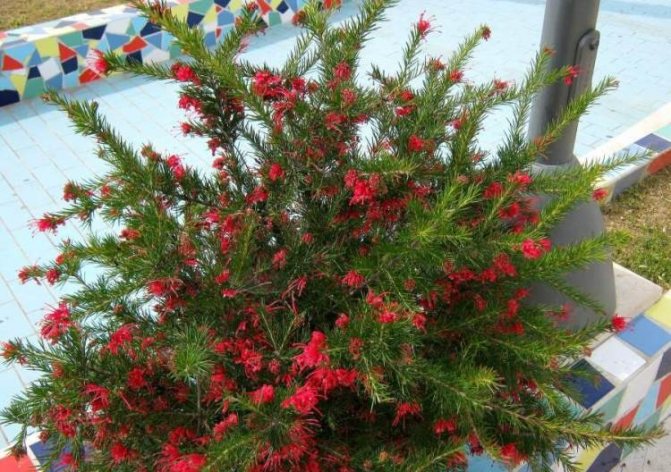

Grevillea rosmarinifolia.
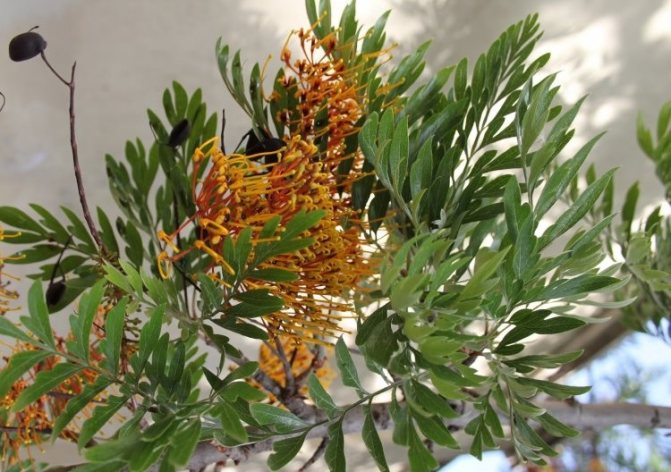

Grevillea robusta.
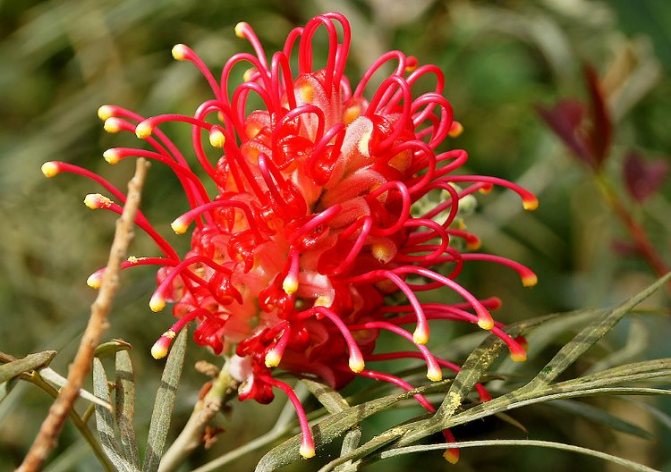

Grevillea banksii.
There are more than 300 types of grevillea, but only a few of them are popular in indoor floriculture:
- Grevillea rosmarinifoliawhose long and narrow leaves resemble rosemary.
- Grevillea robusta, very similar to a fern, but has nothing to do with it.
- Grevillea banksii, a distinctive feature of which is the seamy part of the leaves - it is pubescent and has a silvery color.
Grevillea home care
For the Grevillea plant, it is necessary to provide bright diffused light, but at the same time it must be protected from direct sunlight from April to September. In winter, the plant must be kept in bright light.
In summer, open fresh air is recommended for the plant, but at the same time it is necessary to choose the right place, which will be protected from direct sunlight and strong wind currents.
In the spring and summer seasons, Grevillea is provided with an optimal temperature of content ranging from 19 to 24 degrees, and in winter this temperature limit decreases from 6 to 12 degrees.
Main types
Grevillea large (Grevillea robusta)
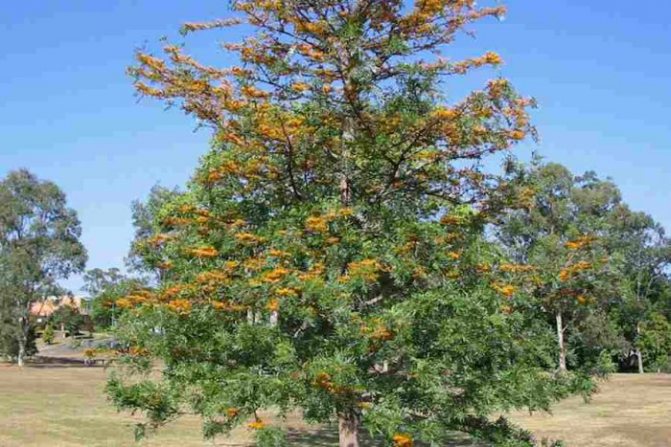

This tree in natural conditions can reach a height of 14 meters. Short-petiolate, pinnate leaves with 25–35 broad-lanceolate cut segments, ranging in length from 15 to 20 centimeters. The obverse is colored deep green, it is smooth and has a distinct venation of the lobes. The seamy side has a slight pubescence. Horizontally arranged, axillary inflorescences are composed of orange flowers. In length, they reach 12 centimeters, and outwardly they are very similar to the longitudinal halves of the cylinders. This unusual shape of inflorescences is created by pistils directed in one direction, or rather, up.
Grevillea banksii
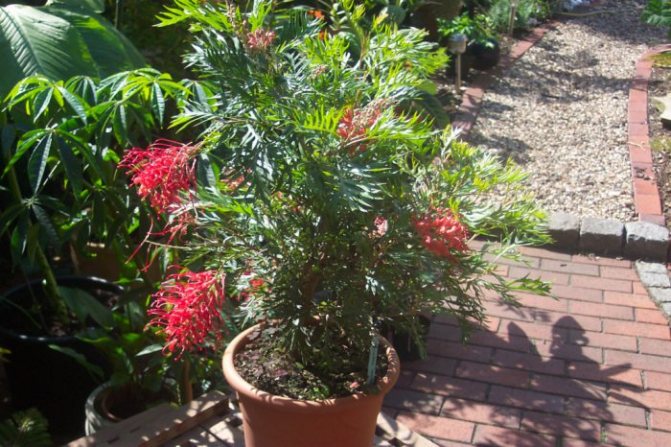

It is presented in the form of a compact tree (height up to 5 meters) or a bush. The pinnate leaves reach 10 to 20 centimeters in length and consist of 4–11 entire narrow-lanceolate lobes.The smooth front side of the leaves is colored greenish-gray, and the pubescent back side is silver. Red-scarlet flowers are collected in axillary and apical inflorescences, having the shape of a cylinder. In length, they reach from 5 to 10 centimeters. A distinctive feature of long pistils is their tips bent by a rather large hook. Thanks to them, the inflorescence looks like a curly brush.
Grevillea rosemary (Grevillea rosmarinifolia)
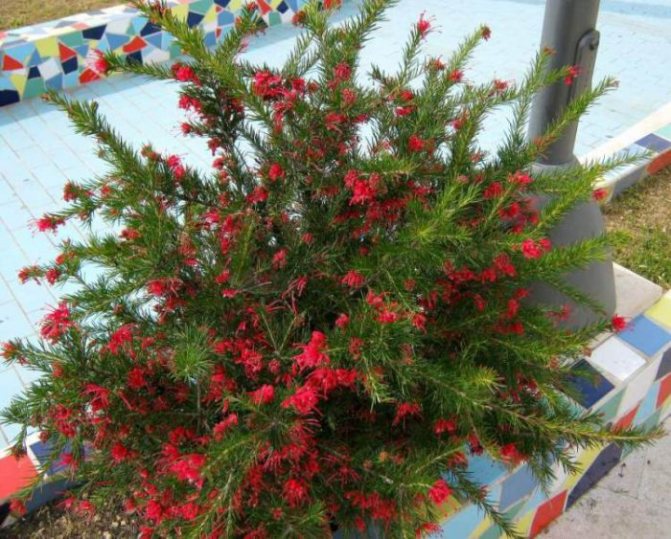

It is presented in the form of a tall (1.5-1.8 meters) bush. Sessile green leaves have a narrow-lanceolate shape, almost acicular. The branches are literally covered with them. Bicolor flowers are white-red and are collected in apical few-flowered inflorescences having the shape of a brush.
Watering and humidity
In the spring-autumn period, the plant needs to provide regular watering, with settled and soft water, as the top layer of the soil dries up. By the end of the autumn period, watering is limited to moderate, and in winter it is watered without drying the earthen coma.
The Grevillea plant loves high indoor humidity. It is recommended to spray regularly with warm, settled, soft water. It is possible to increase humidity using a pallet with wet peat or expanded clay, but at the same time the bottom of the dishes should not touch the water.
A tree with leaves like a fern
Grevillea (Grevillea) is a small genus of ornamental plants that are actively used in ornamental floriculture. Within the natural habitats of Australia, Grevilleas are real giants, growing up to 35 m in height. In room culture, they are much more restrained and will not exceed 2 m, and often even more compact. At the same time, the height of the plant itself is easy to control by pruning.
The most widespread in room culture is the type that is also called silk oak. Grevillea large, or powerful (grevillea robusta) - a tree-like herb with feathery leaves, which at first glance cause associations with ferns. Thin feathery leaves with a filigree section of lobes reach 30 cm in length and are the main pride of Grevillea.
The foliage colors of this beauty range from forest green to green-bronze or silver, while growing conditions often change the base tone to a brighter or, conversely, darker one. An attractive gloss only adds beauty to it: thanks to the shine, the plant always seems radiant and fresh. Indoors, you will not be able to enjoy the flowering of Grevillea: it can bloom only when grown in open ground.
In addition to large grevillea, you can also find on sale:
- Greville Banks (Grevillea banksii) - treelike shrub with pubescent young shoots, more modest, only up to 20 cm in length with double pinnately dissected leaves with a reddish edge of the lower side;
- Alpine grevillea (Grevillea alpina) is a densely branched shrub up to a meter high with open shoots covered with a beautiful edge and narrow leaves with a rounded tip up to 2.5 cm in length with a very dark color.
Rest period and pruning
The plant has a pronounced dormant period in winter. During this period of time, she needs to be kept in a cool and bright room at a temperature of 6 to 12 degrees, watering during this period should be limited, but not allowed to dry out the earthen lump. Top dressing is done 2 times a month during the period of intensive growth from spring to October, using complex fertilizers.
It is necessary to prune the plant in a timely manner in order to create a compact crown, if this is not done, the plant will stretch out and reach large sizes, which will be useless at home.
Pests
Spider mites annoy the plant more than others. The risk of infection is greatly increased if kept in too warm conditions or excessively dry air.Often you can get rid of the problem by simply adjusting the conditions of detention, by frequent spraying.
In home and garden interiors, the Grevillea always plays the role of a soloist, she is never placed in a plant group. This is due not only to its bright individual appearance, but also to the requirements for a spacious single growth.
Transplant and soil composition
Young Grevillea under 3 years old needs an annual transplant in the spring, older specimens are transplanted once every two years, if it is a tub plant, then the transplant is carried out as the tub decays, but the substrate is added annually. The plant does not feel well in too deep containers, it grows and develops worse.
The soil is made up with an acid reaction from a mixture of 2 parts of coniferous soil, 1 part of leaf land, 1 part of peat soil and 1/2 part of sand by adding brick chips to this substrate. Be sure to provide the plant with good drainage.
Reproduction
There are two ways to propagate this plant - seed and cuttings.
On the territory of the Russian Federation, the easiest way is to buy seeds that are distributed. Unfortunately, the packaging does not indicate what type they belong to, and the inscription "Green Island" is nothing more than trade name.
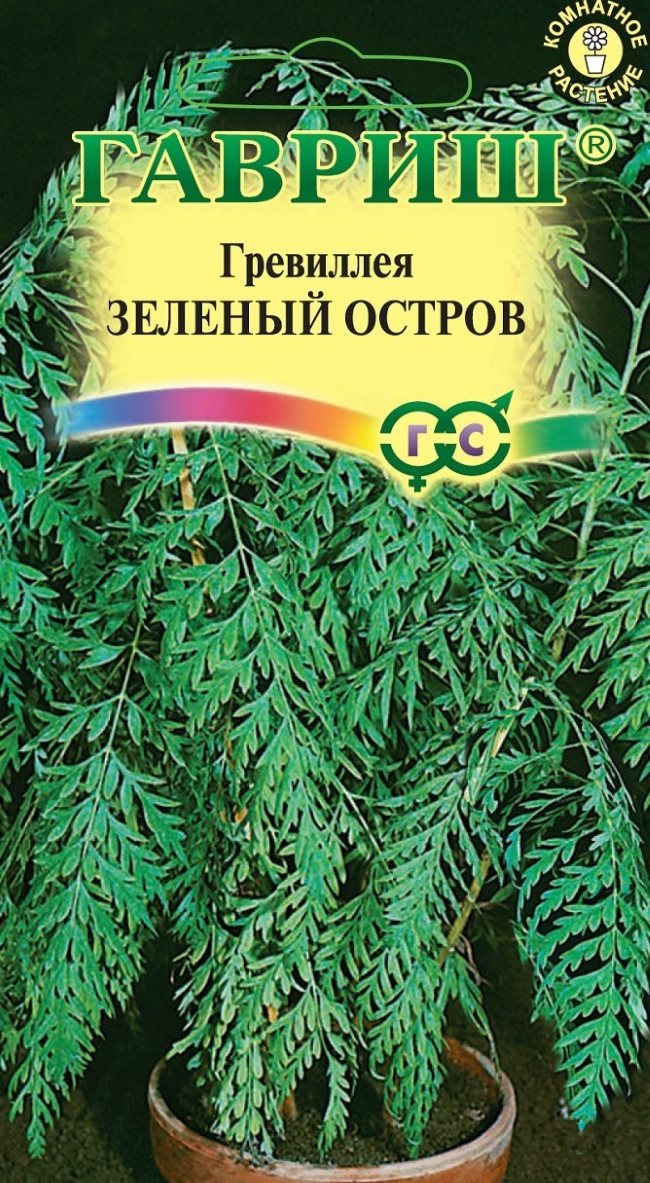

This is how a branded package with grevillea seeds from.
Judging by the appearance of the seedlings successfully grown by amateur flower growers, it can be assumed that this is Grevillea robusta.
Seeds
As long as the seeds are fresh, their germination rate approaches 80%, but with long-term storage, it rapidly decreases. For this reason, when buying, you should pay attention to the year of collection, and if it is not indicated, then on packing date.
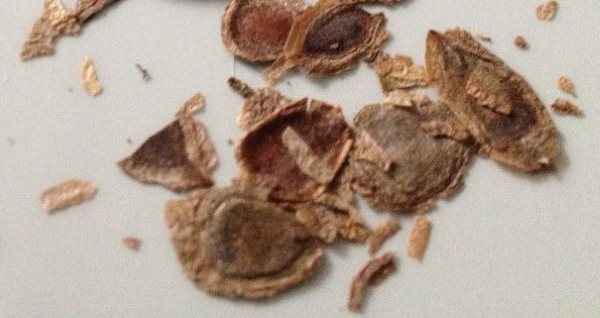

Grevillea seeds are quite interesting to look at, flat and very fragile.
You can sow at any time of the year, but better in early spring, then the seedlings will have enough natural daylight. In autumn and winter, the seedlings will have to be supplemented with powerful fluorescent lamps.
Sowing soil should be light, have a neutral or acidic reaction. From store soil mixtures, you can use a universal peat-based one.
- Seeds are spread on moistened soil, after which they are sprinkled on top with a thin layer of dry.
- The container used for germination is covered with foil to create a greenhouse effect.
- From time to time, the film is removed for ventilation.
- If the humidity has decreased, the soil is sprayed with warm water.
The first shoots will appear two to three weeks later... When the plants get a second true leaf, they should be cut into small pots or cups.
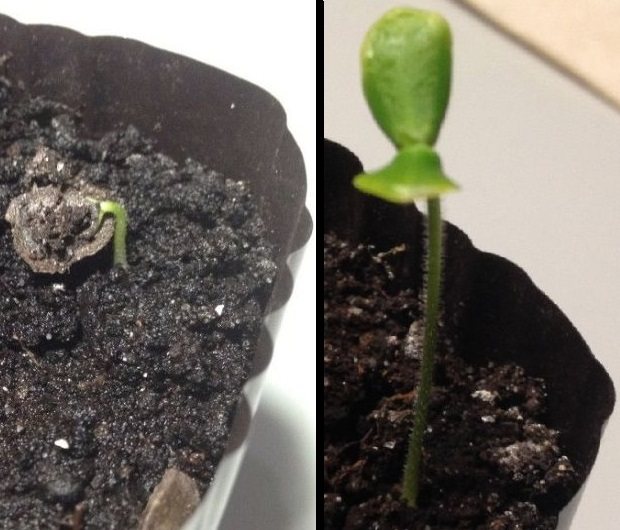

At first, seedlings grow slowly - the first leaves rise in about a week.
By the way, at room keeping grevillea does not bloom, so you won't be able to collect seeds from your plant.
Cuttings
If, during the spring pruning, the semi-lignified parts of the branches were cut, you can cut cuttings "with a heel" from them. Each of them should have 2-3 internodes.
Completely lignified or still green shoots are not suitable for reproduction.
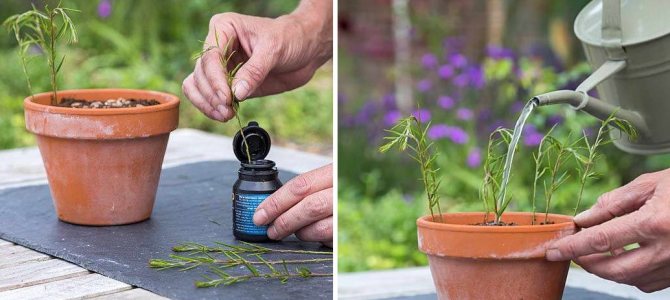

The length of a semi-lignified cutting should be about 8-10 cm.
If no suitable branches were found in the spring, they are purposefully cut off in august or early September.
- Cuttings should be treated with any rooting stimulant and embedded in wet sand.
- So that they do not dry out, the container is covered with a transparent airtight material and periodically ventilated.
Grevillea from seed
Seeds are planted from January to March in pots, boxes or bowls. For germination, a soil composition is taken from 1 part of leafy land, ½ sod land, ½ humus soil and 1 part of sand. They monitor the temperature of the seedlings, which should be in the range of 18 to 20 degrees.
Quite often, a very uneven emergence of seedlings occurs. They must be monitored, as soon as the second real leaf appears, the seedlings must be dived at a distance of 2 * 3 centimeters.It is necessary to keep the seedlings in a well-lit place; care consists only in watering.
As soon as the seedlings grow, they must be planted one at a time in pots with a diameter of 7 centimeters. In such an earthen mixture: 1 part of sod land, 1 part of peat land, 1 part of leaf or humus soil and 1 part of sand. It is also necessary to provide the seedlings with ventilation and protect from direct sunlight.
Care
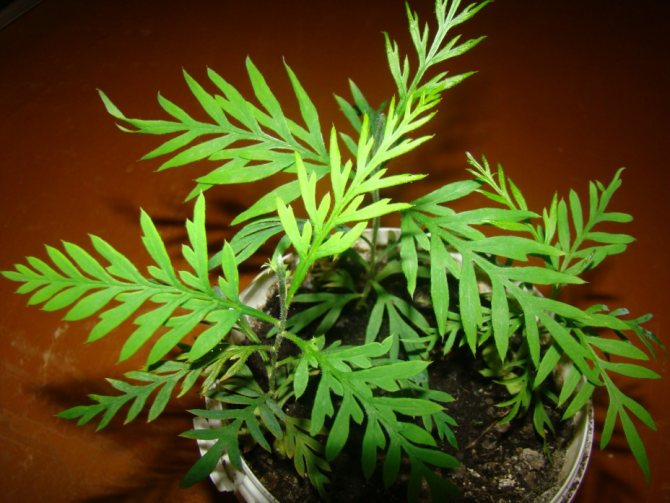

When growing Grevillea, the earthen coma should not be allowed to dry out - the plant immediately "signals" about the lack of moisture by yellowing the leaves.
For a comfortable existence, this plant needs only three conditions.
- Wet air - in a dry microclimate, the leaves begin to turn yellow and dry, therefore, if necessary, they are sprayed with water.
- Cool - in summer, the comfortable temperature ranges from 18 to 22 ° C... And in the winter she will have to provide her from 8 to 12 ° C... The exception is the plants of the first year of life, which hibernate at room temperature.
- Good lighting - the flowerpot should be placed near a window that faces east or north-west, so that in the midday heat it is protected from the scorching sunlight.
Watering
Grevillea needs abundant watering, the water should soak the entire clod of earth. But, not allowedto pot moisture stagnated... In order to avoid decay of the roots, the need for watering is determined by the drying out of the top layer of the soil.
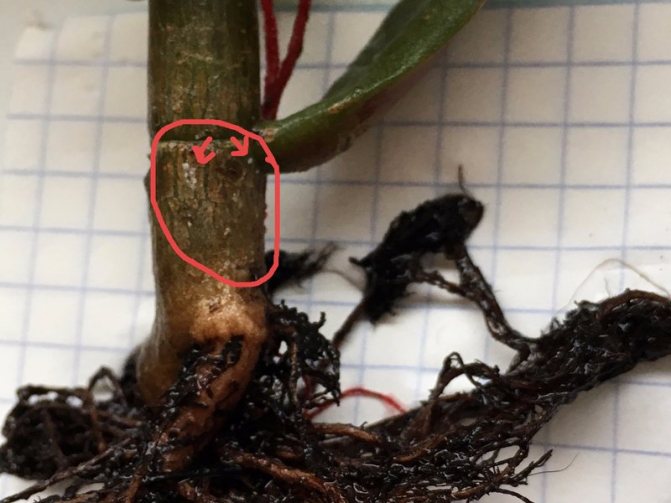

Excessive waterlogging of the soil can lead to the appearance of root rot.
During the dormant period (from October to February), this plant is watered moderately and only after the soil is completely dry.
Top dressing
In spring and summer, once every two weeks, it is recommended to apply universal fertilizer for indoor plants containing nitrogen in the quantities recommended by the manufacturer.
In the cold season, feeding is completely stopped.
Transfer
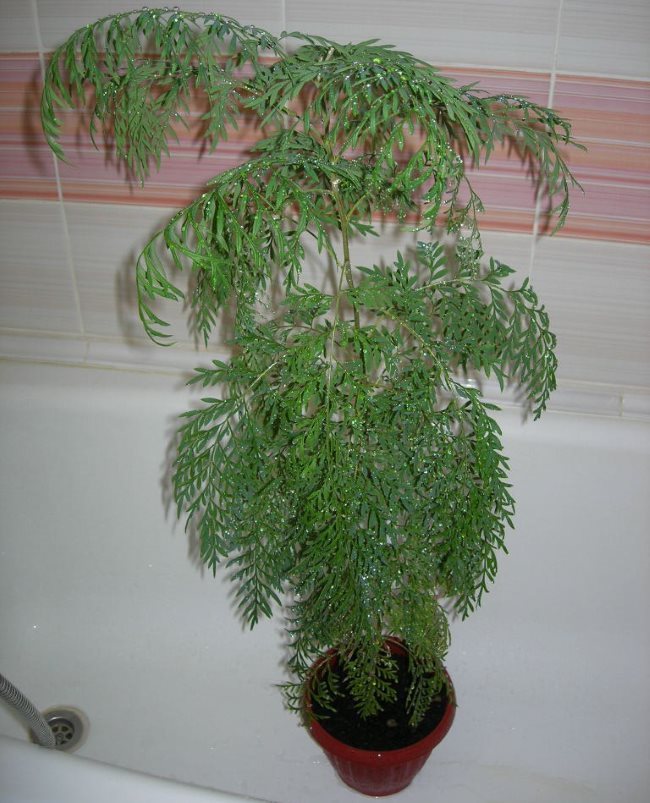

With each transplant, you need to increase the width of the pot.
Young plants are transplanted 1-2 times a year, focusing on the size of the container in which they grow. For small seedlings, the optimal diameter is 8 cm, and when the roots completely fill it, they make the transfer into the pot a few centimeters wider.
Adults, but not very large, grevilleas are transplanted in the spring, at the same time as pruning. And in massive plants, only the top layer of the soil is replaced.
The pot should be wide and not very high. At the bottom, a drainage layer of pebbles or expanded clay is required.
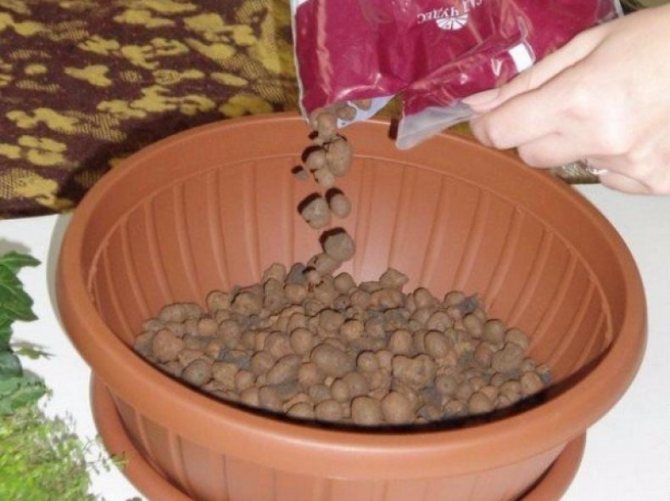

The thickness of the expanded clay drainage layer should be about 2–3 cm.
The soil can be purchased at the store or prepared by yourself by mixing leaf, turf and peat soil in proportion 1:2:1 and adding more 0.5 pieces of sand.
Flower features
Let's first discuss a few points, in particular the origin of the species, its natural habitat. This information will help you better understand the needs of your plant, and as a result, maintain its beauty.
Grevillea belongs to the proteinaceous plants, due to which it has a characteristic structure. In nature, Grevillea is widespread in Australia, in its homeland the plant easily reaches 35 meters in height, but do not be afraid, the decorative variety will never pick up such sizes.
The maximum that will have to be provided is 2 meters in height, and you can also shorten your grevillea by pruning the shoots. In greenhouse conditions, it is customary to grow not all varieties of Grevillea, but only some of its varieties.
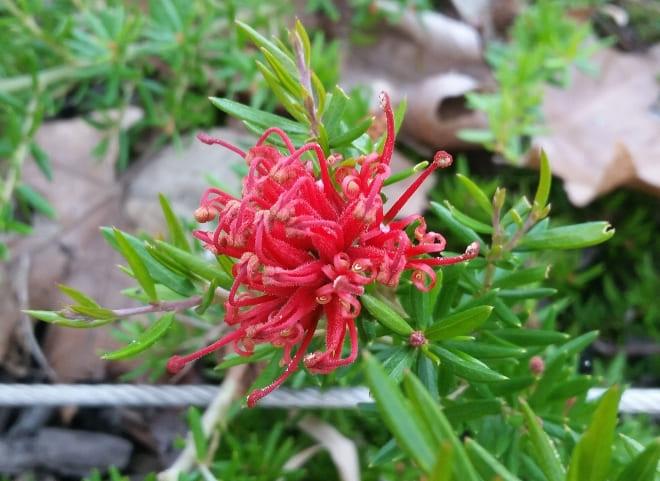

Large grevillea
Otherwise, a powerful grevillea. Feathery leaves are inherent in this herb, which resembles a fern, at least upon inattentive examination. A more detailed analysis of the plant reveals its characteristic features, in particular:
- Lovely long grevillea leaves that stretch for 30 centimeters or more.
- The amazing section of the lobes on the leaves is striking in its accuracy and makes you buy this plant.
- The tones in which the grevillea is painted vary from a noble green hue to silver.
- As it grows, the colors of the Grevillea can change to a darker or lighter side. This process depends on the amount of light and your approach to the flower.
- The light gloss that covers the foliage only enhances the visual qualities of the plant. But, unfortunately, you will not get the flowering of a houseplant.
- Grevillea flowers will dissolve only in open ground, which will delight the owners of land plots and greenhouses.
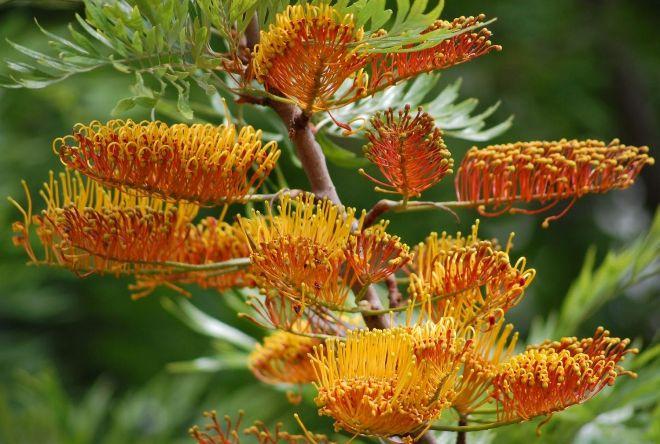

In addition to this famous variety, there are others, less famous, but no less beautiful. In particular Grevillea Banks, which is famous in narrow circles for its colors. Small shoots look down, the whole plant has a somewhat dull look, which, however, does not depress its owner. The average length of the shoots is 20 centimeters, Grevillea Banks is slightly smaller than the powerful variety. The bright, alien-looking buds emit a great scent that adds sophistication to the flower.
Landing
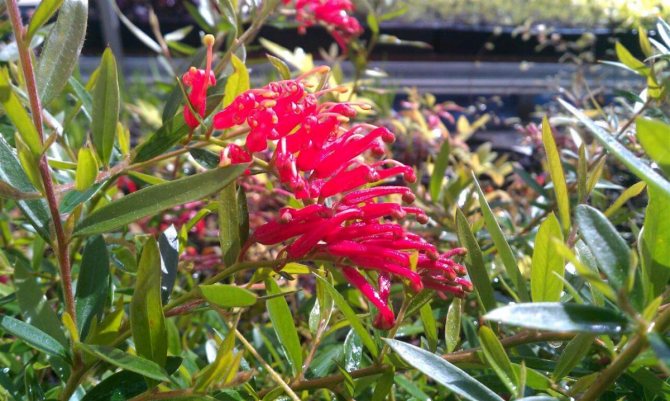

Photo: <>
Young plants up to three years of age need to be replanted every year in early spring. Instances over three years old are transplanted once every three years. As a rule, the flower is grown in volumetric tubs. When the entire volume of the tub is filled with the root system, it is necessary to transplant the plant, in addition, fresh soil must be periodically added throughout the year. This plant does not thrive in very deep containers. The soil in the container where the grevillea grows must have good drainage.
Planting grevillea
For planting, it is best to choose a spacious container. Large and wide vases or decorative boxes can be used. Rapid growth creates an urgent need for space.
For the plant to grow even faster, it will be enough to cut off the tops of the longest branches of the Grevillea.
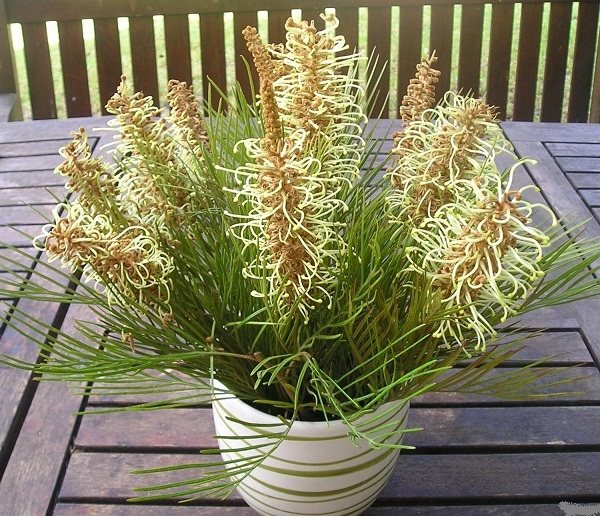

Small containers are fine for planting, but then you will have to replant the plant every year for a three-year period.
As for the most important thing in the whole planting process - the choice of soil, then you must remember the need to provide grevillea with all the nutrients that a highly fertile soil layer can give.
Prepare the soil mixture in this way: take turf, humus, peat, carefully sifted sand and leafy soil. All components must be in equal proportions. Mix everything well, here is the soil for planting grevillea.
Planting the plant is possible using seeds or cuttings. And in either case, unlike other indoor plants, Grevillea will give quick results in germination and growth.
It is a pity, however, but, as a rule, the flowering of Grevillea in an apartment or house is not possible. It blooms only in its natural habitat.
After planting, it is recommended to water the grevillea abundantly.
Reproduction of grevillea
New grevilleas at home can be obtained from seeds. Sowing them should be carried out in early spring, together with the first garden summers. They are sown in large containers or boxes, in a lightweight universal substrate. They germinate only in warmth, in the usual room temperatures. In this case, the inputs appear unevenly. It is better to dive only after the appearance of the second true leaf, into individual pots.
You can try to get new plants from half-ripe cuttings, which are cut from low shoots, not branched and thin, cutting them together with the "heel" in August. The cuttings of the Grevillea do not root in the substrate, but in moist sand. Treatment with growth stimulants is required.
Botanical description
Grevillea is a perennial evergreen of the Protein family. It grows in the form of a shrub or a large tree (height up to 35 m), when grown indoors, it is limited to a height of 2 m.
The interest of flower growers in grevillea is caused by the structure of the leaves.Each leaf is elliptical, simple. Alternately attached leaves make up a leaf plate up to 30 cm long. In general, it resembles a fern vayu or thuja needles. The reverse side of the leaves is covered with fine pile, which makes the surface silky. The leaves are soft to the touch, their color is deep green.
Grevillea bloom
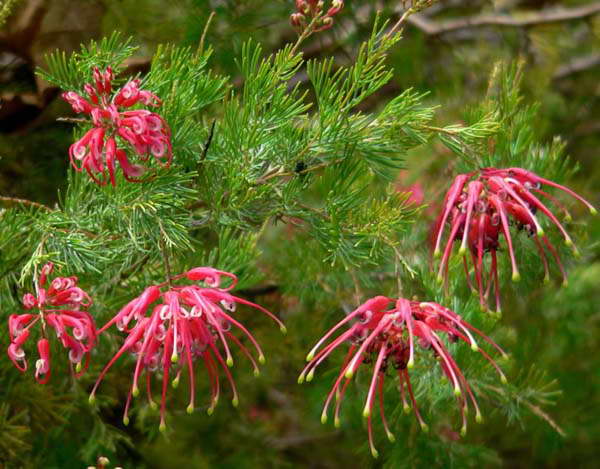

How grevillea blooms photo
Grevillea flowers look like long narrow tubes. They gather in large spike-shaped or racemose inflorescences. Flowers can be white, but bright shades (pink, orange, red) prevail. By the way, thanks to the sweet nectar, the flowers of certain types of Grevillea were eaten by the locals.
Where is found
Most of the Grevillea species are common in the tropics of Australia, some can be found on the islands of New Guinea, Caledonia, Sulawesi, and Moluccas. Focusing on tropical origin, it is necessary to create appropriate conditions for indoor growing: bright lighting, warmth, high humidity.
Grevillea is a flowering plant, but rarely blooms at home. Most often, Grevillea is grown as an ornamental deciduous tapeworm in bright, cool rooms.
The first description of grevillea dates back to 1809, and the name of the plant was given in honor of Charles Greville (English botanist, member of the Royal Society).
Types of grevillea with photos and names
In the natural environment there are about 370 species of Grevillea, some of them are cultivated.
Grevillea woolly Grevillea lanigera
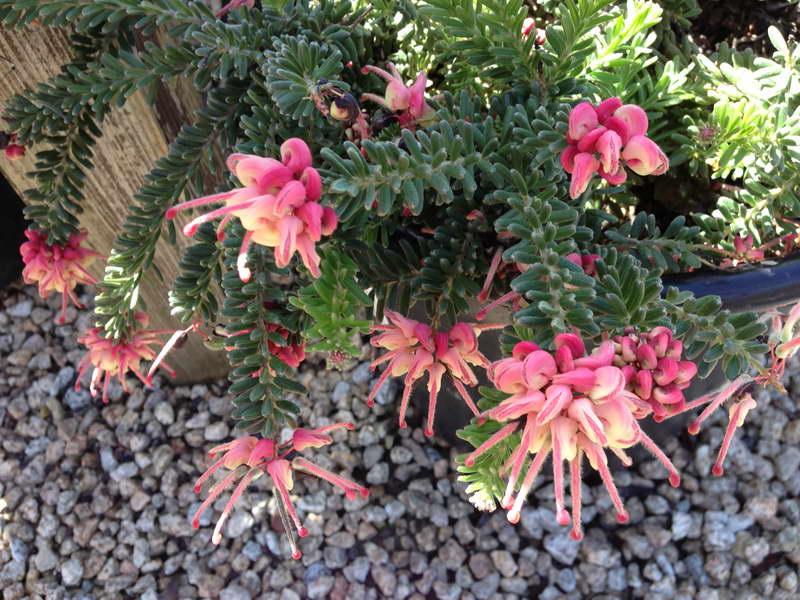

Grevillea woolly Grevillea lanigera photo
A resident of South Australia, this beauty has become a favorite of flower growers around the world. The plant fell in love with its exotic appearance and relatively low height. The shrub is quite variable, and the different varieties grow from 30 to 1.5 cm in height.
Of particular interest are the leaves with felt pollination, which gives the plant a slightly fabulous look. The flowers are massive, located along the edges of the branches, and resemble giant spiders.
The plant tolerates slight frosts, so that the inhabitants of the regions in mild winters (frosts down to -12 ° C) may well grow woolly Grevillea in the garden and leave it there for the winter.
Grevillea juniper Grevillea juniperina
Grevillea juniper Grevillea juniper Grevillea juniperina Grevillea juniper photo
The name of the species is obtained due to the external similarity of the leaves with the juniper. Abundant flowering, flowers with long red stamens topped with large yellow anthers, which gives the plant an enchanting look, resembling a fireworks display against a dark green background of bright foliage. The flowers are also orange and yellow. The plant is very elegant, it can decorate a summer garden, a greenhouse, the interior of residential and public buildings.
Plants of this genus reach a height of 20 cm to 3 m. They prefer clay and loamy soils. It blooms from winter to early summer, some species bloom from September to February. This is an erect shrub, inflorescences are located at the tips of branches, sometimes in the axillary buds. It reproduces well by seeds.
Grevillea alpine Grevillea alpina
Grevillea alpine Grevillea alpina photo
It is a low-growing (about 1 m high) well-branched shrub. Shoots are densely covered with soft tomentose pubescence. The leaves are narrow, elliptical, have blunt tops and slightly curled edges. The surface of the leaves is dark green, with pubescence on the reverse side. Inflorescences appear at the tops of the shoots. Oblong tubular flowers are collected in bunches of several pieces, forming a panicle. The base of the flowers is reddish and the tips are yellow.
Grevillea banksii
Grevillea Banks Grevillea banksii photo
A shrub or tree up to 5 m high. The leaf plates reach a length of 10-20 cm, they consist of 4-10 lobes. Leaflets are oblong, smooth margins with pointed tips.The surface of the leaves is glossy, dark green in color, the reverse side of the leaf is slightly pubescent with an orange pile. The peduncle and perianth are also covered with dense, but barely visible hairs. The racemose inflorescences "burn" with a bright red hue.
Grevillea strong or large Grevillea robusta
Grevillea powerful Grevillea robusta photo
The species is better known as silk oak - a tree 24-30 m high with a spreading crown. In the natural environment, these beauties are found in Australia (Victoria forests) and New Wales. Branches and shoots appear grayish due to pubescence. The leaf plates are doubly pinnate; the length of each segment is 15-20 cm.
Leaves are lanceolate with jagged edges. The surface of the leaf is bare, green, the underside is slightly pubescent, has a yellowish tint. The racemose inflorescences consist of bright orange flowers. When grown at home, the size is more modest (height is 2-3 m), flowering is extremely rare.
Grevillea rosemary Grevillea rosmarinifolia
Grevillea rosemary Grevillea rosmarinifolia photo
Spreading shrub 1.5-2 m high. Leaves are oblong, narrow, acicular. They densely cover the shoots, it looks like a Christmas tree. Tubular white-red flowers gather in racemose inflorescences.
Grevillea candelabra Grevillea candelabroides
Grevillea candelabra Grevillea candelabroides photo
A large shrub, reaching a height and width of about 3 m. The leaf plates are pinnate, consisting of almost filiform flowers. Snow-white flowers are collected in dense fluffy inflorescences. The cylindrical inflorescence reaches a length of 25 cm.
Possible problems
Poor growth of vigorous Grevillea is a sign of insufficient lighting or a lack of nutrients. In this case, the plant must be fed once every two weeks, placed in a more illuminated place, and in the spring - transplanted into fresh soil.
If the soil in the pot dries out, the leaves of the plant will turn yellow and fall off. In this case, the pot of grevillea should be lowered into a bucket of water for about half an hour.
Among the pests, such a plant can infect whiteflies - light flies that take off from the grevillea when touched. To get rid of them, the plant should be treated with an insecticidal preparation, having previously tested its effect on the lower leaves.


Reproduction - step by step instructions
The life form of the grevillea is an evergreen bush or tree with many fast-growing shoots and needs to be pruned periodically. The plant is viable and propagates easily with cuttings or seeds.
Cuttings
For the propagation of an ornamental bush, you need to choose strong, stiff tops of the shoots. The most suitable time for this procedure will be August. To get a healthy plant with exotic leaves, you need to properly divide the shoot into cuttings.
- The most suitable for grafting is the part of the stem that has begun to be covered with a woody layer;
- With a sharp knife, the selected shoot is cut off, the length of which is 15-20 cm;
- It is necessary to cut off the upper green part of the shoot;
- Divide the remaining stalk into parts so that at least two nodes (dormant buds) remain on each.
- It is better to remove the green part of the leaves, since a lot of moisture evaporates through the leaf blade.
- The cutting gratefully responds to the treatment of the lower part with a root.
- The shoot treated with a growth stimulator for rooting is planted in a container filled with a mixture of turf soil and river sand and covered with a transparent jar or bottle to create greenhouse conditions.
REFERENCE. The knot is the place on the handle from which the leaf grows, and the distance between the knots is called the internode.
Seeds
The seeds of this luxurious, lacy, spreading plant look like large brown grains.They quickly lose their germination, so you need to closely monitor the expiration dates and use only fresh material.
- Grevillea seeds can be planted in mid-February in a shallow container.
- The soil should consist of a mixture of turf and leafy soil with river sand. The seeds should be sown 1 cm deep.
- To ensure better germination, water the sown grains with warm water.
- To germinate Grevillea seeds, you need to choose the warmest place in the room, and place the bowls there.
- After the sprouts appear, young seedlings should be transferred to a well-lit, warm place.
- After the appearance of the second leaf, the sprouts can be dived into small pots with a diameter of 10 cm.
Planting and caring for Grevillea outdoors
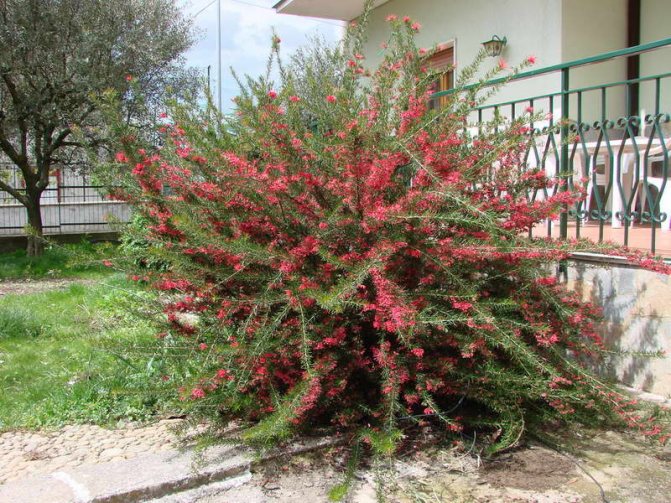

Grevillea juniper in the open field cultivation and care
When to plant
Grevillea is planted in the garden in early autumn, this is the ideal time for successful rooting. Spring planting is also allowed, but with frequent watering until the plant is accepted.
Priming
Prefers sunny areas, partial shading is allowed. The shrub thrives on poor, well-drained, acidic and neutral soils. Does not tolerate flooding and moisture stagnation.
Watering
It is not difficult to care for Grevillea: in the presence of precipitation, there is practically no need to water, especially if the plantings are mulched with any organic residues: mowed grass, straw, sawdust or needles. However, during periods of severe drought, you will need to water sparingly.
The shrub tolerates pruning well, so it can be used to create a hedge, to give any shape you want.
Top dressing
The plant does not require a lot of nutrients in the soil. Ordinary garden land will provide the shrub with everything you need. There is no need to feed Grevillea. Provide a layer of mulch of about 10 cm, which will become a natural top dressing.
Wintering
Grevillea tolerates a short-term drop in temperature to -12 ° C, but with prolonged exposure to temperatures below -10 ° C, it is prone to freezing. In the southern regions, wintering in the garden is allowed, but subject to good shelter. In the middle lane, the plants are transferred to flowerpots and stored in a cool room with good lighting until spring, with occasional watering.
Grevillea species
- Alpine Grevillea (Grevillea alpina) is a shrub with low height and strong branching. Its dimensions rarely exceed 1 meter. On the shoots, leaf plates grow very densely, and there is pubescence in the form of a delicate whitish felt. The leaves take outlines from narrow-lanceolate to narrow-elliptical, about 2.5 cm long, dull at the apex, the edges of the plate are slightly curled. On the underside of the leaf there is a silky pubescence, and the top is painted in a dark emerald color. The flowers are located at the tops of the shoots and are small in size, from which small bundle-shaped inflorescences are collected, in which there are only a few buds. Petals in flowers at the base are colored red, at their tops are yellow.
- Grevillea Banks (Grevillea banksii) can have both a shrub form of growth and grow in the form of small trees. Their dimensions rarely exceed two meters. When the shoots are still young, they are covered with dense pubescence. The leaf plates have double pinnately dissected contours, the number of segments varies from 4 to 11 units. Each such leaf lobe is distinguished by a narrow-lanceolate shape, its color is green on top, and the reverse side, pubescent with small reddish hairs. The length of the entire leaf ranges from 10–20 cm. The pedicels and perianths also have pubescence, which is provided by small, dense and very fluffy hairs. Pedicels and perianths begin their growth from the axils of the leaf plates growing at the tops of the branches. The petals of flowers are painted in bright red or deep pink color.From 2-3 pieces of buds, racemose inflorescences are collected.
- Grevillea robusta (Grevillea robusta) can be found under the name "Silk Oak". This tree-like representative of the flora can reach up to 3.5 meters in height. The branches usually grow bare, with a gray bark, and the shoots have short pubescence. Large leaf plates, reaching 15–20 cm in length. Their surface has a double-pinnate dissection, at which 25–35 lanceolate leaf lobes are formed. The edges of the leaves are folded or coarsely toothed, the upper surface of the leaf is bare, and the reverse side with pubescence is yellow. The flowers are up to 12 cm long and have a fragrant aroma. One-sided lateral racemose inflorescences with orange-colored flowers are collected from the buds. The native territories of this species are considered to be the lands of New South Wales, Victoria (on the Australian continent), where the plant likes to settle in humid forests with a subtropical climate. The plant is usually grown in cool rooms, flowering is rare.
- Grevillea rosmarinifolia (Grevillea rosmarinifolia) has a shrubby form of growth, the height of shoots rarely exceeds 1.8 m. They have dense pubescence. The leaf plates are whole-edged with narrow-lanceolate outlines, up to 10 cm in length. At both ends, the leaf has a narrowing and sharpness. Above, the surface is bare, and the underside of the leaf is covered with silky hairs. Flowers appear devoid of pedicels (sessile). From them, multi-flowered inflorescences of racemose outlines are collected. Their location is finite, the length is short. The petals of the buds that make up the inflorescence are distinguished by a blood-red color, their tube is curved, its length reaches 1 cm.
- Grevillea johnsonii is a rounded shrub. Leaf plates with a glossy surface, their contours are pinnate. The foliage is painted in a dark green color scheme. The size of the plate varies between 12-25 cm. The flowers appear with pink-cream, as if poured from wax petals. A high-lying inflorescence is collected from them.
- Grevillea tilmaniana (Grevillea thelemannina) is distinguished by a variety of varieties: it can be both creepers and plants with a shrub form of growth. The leaves are feathery with a color ranging from grayish green to pure green. The flowers are collected in bunch-shaped inflorescences. The petals of the buds are pink with green dots.
- Grevillea juniperina is a shrub with a rounded crown. Leaves are thin outlines, their shape can vary from spear to simple. The flowers form inflorescences with slightly hanging contours. The color of the petals of the buds is very diverse.
- Grevillea beadleana (Grevillea beadleana) has a shrub form of growth and small size. The flowers are painted in a dark red tone.
- Grevillea thyrsoides (Grevillea thyrsoides). In this plant, leaf plates are pinnate, with a deep dissection into segments-lobes. The color of the petals in the flowers is pinkish. There are varieties with pure red buds "Cunberra" and the species "Constance", the petals of which are shaded with an orange-red color scheme.
What a grevillea looks like, see this video:
Grevillea home care
Reproduction methods
The plant can be propagated by both seeds and green parts. Seeds for seedlings are sown in March, deepening them by 1 cm. In order for the seeds to germinate better, it is recommended to wrap them in a damp cloth. The soil for sowing should be very light, saturated with air. Boxes or containers with sprouting seeds should be covered with glass for a greenhouse effect.
Cuttings
These plants, like many decorative deciduous plants, are often propagated by green cuttings. The survival rate of cuttings is very good. For grafting, use the tops of branches 15-20 cm long.They are planted for rooting in containers with a mixture of soil and sand and covered with a plastic bag or glass cover to create a greenhouse environment. A stimulant solution can be used for better growth.
Varieties and types
Alpine Grevillea is a low-growing, highly branching shrub, reaching up to 1 meter in height with outstretched, pubescent, soft-felt and densely leafy shoots.
The foliage is narrow, linear or elliptical, reaching up to 2.5 centimeters in length, with a blunt tip slightly curled edge, the underside is silky-pubescent, and the upper side is dark green in color. The flowers are apical, small in size, collected in a small bunch of several pieces. Petals with yellow tips, red at the base.
Grevillea Banks is a tree-shaped shrub reaching several meters in height. Young shoots are covered with rather dense pubescence. Leaflets reach up to 20 centimeters in length, dissected twice pinnate.
Each segment is narrow-lanceolate, covered with barely noticeable red pubescence from the lower part, and green in color from the upper part. The flowers are collected in racemose inflorescences with a bright red saturated color. The perianth and pedicel are also covered with barely noticeable, fluffy and thick hairs.
Silk oak, or Grevillea vigorous wild, is found in the humid forests of Victoria (Australia) and New South Wales. These trees can grow up to 24-30 meters in height.
They have shortly pubescent, glabrous and gray branches, leaflets are doubly pinnate, coarsely toothed, lanceolate lobe plates up to 15-20 centimeters in length, glabrous and green from the upper part, and yellowish pubescent from the lower part. The inflorescences are collected in orange clusters. Cultivation takes place in cold rooms with very rare flowering.
Flowers
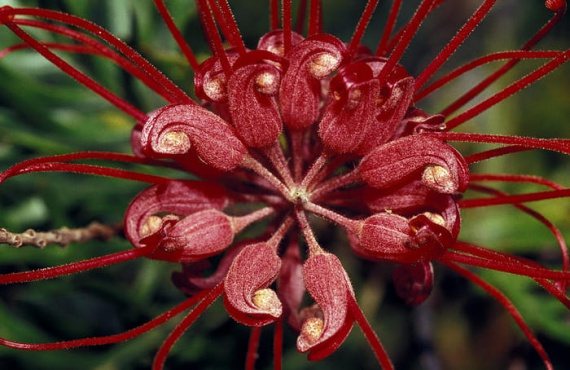

Family: Proteaceae (Proteaceae). Homeland: Australia, the islands of New Caledonia, New Guinea, Moluccas, Sulawesi. Bloom: in room conditions, it practically does not bloom. Height: middle. Shine: bright absent-minded. The plant should be protected from direct sunlight. Temperature: in spring and summer, the optimum temperature is in the region of 19-24C, in winter it is necessary to keep the plant in cool conditions at 6-12 ° C. Watering: from spring to autumn, regular, as the upper layer of the substrate dries up, with soft, settled water. From autumn, watering is limited and watered in the winter in moderation. Air humidity: high. Needs regular spraying. Top dressing: complex fertilizer, 2 times a month, from spring to October. Cropping: regular. Rest period: in the autumn-winter period. The plant is kept in a bright place at a temperature of 6-12C, watered carefully. Transfer: in spring, young and 2 - 3 year old plants are transplanted annually; over 3 years old - once every 2 years; tubers - as the tubs rot, however, they add the substrate annually. Reproduction: seeds and cuttings. The genus Grevillea (Grevillea R. Br. Ex Knight.) Has up to 200 plant species belonging to the Proteaceae family. Distributed mainly in Australia, on the islands of New Caledonia, New Guinea, Moluccas, Sulawesi.
The genus is named after the English botanist Charles Greville.
Evergreens, trees and shrubs. Leaves are alternate, simple, elliptical or simple. Flowers are collected in brushes, of various colors, bisexual.
In indoor conditions, grevilleas can reach a height of 2 m. In culture, the plant is grown for its thin feathery leaves, the length of which reaches 30 cm. Flowering in indoor conditions usually does not begin. The plant is quite difficult for indoor floriculture, as it does not tolerate warm wintering and needs high humidity.
Grevvillea is used as a tapeworm in bright, cool rooms.
Views:
Alpine Grevillea (Grevillea alpina Lindl.).Strongly branching undersized shrub up to 1 meter in height, with outstretched soft-tomentose-pubescent densely leafy shoots. The leaves are narrow, linear to elliptical, 2.5 cm long, the apex is obtuse, the edges are slightly curled, alkali-pubescent below, dark green above. Small apical flowers are collected in several pieces in small bunches. The petals are red at the base, the tips are yellow.
Grevillea Banks (Grevillea banksii R. Br.). Treelike shrub several meters high. Young shoots are covered with fine dense pubescence. Leaves are bipinnate dissected, about 20 cm long. Each segment is narrow-lanceolate, green above, covered below with fine reddish pubescence. Bright red flowers are collected in racemose inflorescences. Pedicels and perianths are also covered with fine, dense and downy hairs. The ovary is covered with pubescence.
Powerful Grevillea (Grevillea robusta A. Cunn. Ex R. Br.) Or Silk Oak. Grows in subtropical rainforests in New South Wales, Victoria (Australia). Trees up to 24-30 m tall; branches glabrous, gray; shoots shortly pubescent. Leaves are double-pinnate; lobes lanceolate, 15-20 cm long, coarsely toothed, green and glabrous above, yellowish pubescent below. The flowers are collected in brushes, orange. Cultivated in cold rooms (rare flowering).
Plant care:
For Grevillea, bright diffused light is needed; in the period from April to September, the plant is protected from direct sunlight. In winter, they are kept in a place with bright light. The plant needs fresh air. In the summertime, it is recommended to take the grevillea out into the open air, in a place protected from direct sunlight.
In spring and summer, the optimum temperature for Grevillea is around 19-24 ° C, in winter it is necessary to keep the plant in cool conditions at 6-12 ° C.
Watering from spring to autumn is regular, as the top layer of the substrate dries up. Since autumn, watering is limited and watered in winter in moderation, without bringing the earthen coma to dryness. Watering is carried out with soft, settled water.
Grevillea prefers high humidity. It is recommended to regularly spray the plant with soft, settled water at room temperature. You can put a container with a plant in a tray with wet expanded clay or peat. In this case, the bottom of the pot should not touch the water.
The plant has a dormant period. Grevilleas need to be kept cool during the winter. Plants overwinter in cold, light rooms (temperature 6-12 ° C); in winter, watering is limited, but the clod of earth is not brought to dryness.
During the period of intensive growth, top dressing is applied with complex fertilizer, 2 times a month, from spring to October.
Grevillea needs timely pruning (to create a compact crown), since without it the plant stretches and can reach large sizes
Plants 2-3 years old are transplanted annually in the spring; over 3 years old - once every 2 years; tubers - as the tubs rot, however, they add the substrate annually. Grevilleas do not grow well in larger containers. The pot should not be too deep. The soil must be acidic. A mixture of 1 part leafy soil, 2 parts coniferous, 1 part peat and 1/2 part sand with the addition of brick chips is suitable. Provide good drainage at the bottom of the pot.
Propagated by seeds and cuttings.
Seeds are sown in January-March in bowls, boxes, pots. The composition of the earthen mixture: leaf - 1 hour, soddy - 0.5 hours, humus - 0.5 hours, sand - 1 hour. For germination, the temperature is maintained at least 18–20 ° C. Seedlings often appear unevenly. When the second leaf appears, the seedlings dive into boxes or bowls at a distance of 2 × 3 cm. The seedlings are kept in a bright place. Care for them consists in watering. Upon growth, seedlings are planted in 7-centimeter pots, 1 copy each. The composition of the soil is as follows: turf - 1 hour, peat - 1 hour, humus or leaf - 1 hour, sand - 1 hour.Necessary shading from the bright rays of the sun, airing.
Reproduction by semi-ripe cuttings is carried out in August. It is advisable to cut cuttings from low-growing plants with unbranched shoots. Root them in moist sand. Rooted cuttings are planted in 7 cm pots.
Damaged: not clarified. floralworld
Grevillea: how to grow and propagate a plant at home
Grevillea belongs to the genus of representatives of the flora attributed to the Proteaceae family, which includes dicotyledonous plants with two oppositely growing cotyledons in the embryo. Most of all, the area of distribution of Grevillea falls on the lands of the Australian continent, the islands of New Guinea, New Caledonia and also the territory of the Indonesian island of Sulawesi. This genus includes up to two hundred varieties. The plant was first described at the beginning of the 19th century (in 1809) and the term "Grevillia" was chosen to define it. The flower owes this name to the Honorable Sir Charles Francis Greville (1749-1809), who was a renowned British antiquarian, botanist, collector and politician. Also, this prominent figure was a member of the Royal Society and the Linnaean Society of London, engaged in research in the classification of representatives of the flora of the planet. This exotic inhabitant of the subtropical regions of the planet is an evergreen flowering plant that can also take both shrub and tree-like forms. Their height can vary from half a meter of shrub shoots leaning to the soil surface to thirty five meter giant trees in its homeland. However, in indoor conditions, the branches can reach only 2 meters in height, especially if the plant is kept cool and with sufficient illumination.
Grevillea leaf plates can grow both attached to the petioles and completely sessile. The outlines of the foliage are also quite diverse: it can be a simple leaf or deeply double pinnately dissected. The leaf edge is either smooth or curved, resembling large teeth. There is also venation along the surface, which varies from reticular to parallel arrangement. The color also varies greatly for each variety: it can be forest greenish, changing to greenish-bronze or even silver. Moreover, the shade of the foliage directly depends on the lighting conditions when growing grevillea. Due to the glossy surface on the leaf plates, the beauty of the plant is enhanced as they look radiant and very fresh. Some people compare the luxurious foliage of this specimen of flora to the fern frond (pinnately dissected leaves). If the plant is grown in rooms, then flowering is observed quite rarely. Usually the flower is bisexual, with tubular outlines, in which the perianth and long column lobes are twisted. The color of the petals of the buds can take on red, pinkish or yellow and orange-red hues. Inflorescences have racemose or bundle-like outlines, the number of flowers from which they are composed is also varied. Because of its effective appearance, Grevillea is best grown as a tapeworm crop for large rooms, halls, lobbies, and the like. The most favorite variety among flower growers is the powerful Grevillea variety, which in its native Australian continent is called "silky oak", since the leaf lobes have a delicate pubescence. The growth rate of this "pinnate" beauty is very high, therefore it is required to carry out a thorough pruning of the crown. In terms of the complexity of care, the plant is medium-difficult, since during cultivation it will be necessary to provide special conditions for keeping during the dormant period and few growers will be able to maintain them.
Preparing to plant at home
Seeds
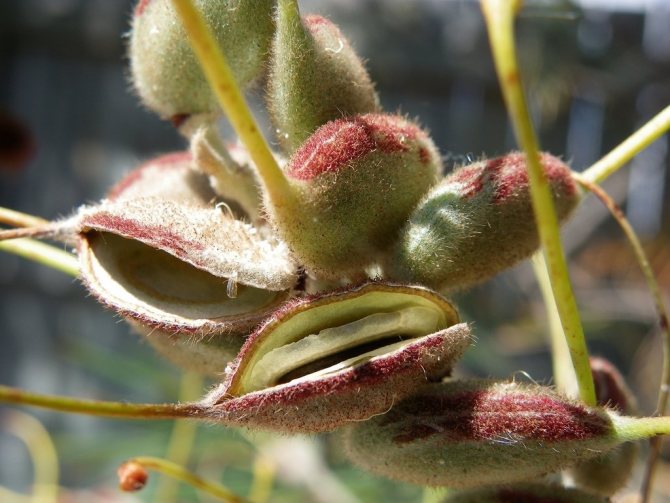

The planting of the seeds of this plant begins in early January, but it is possible until March inclusive. Sometimes seedlings appear unevenly. After the second real leaf appears on young shoots, they dive, seating them at a distance of three centimeters from each other. For cultivation, you need to take only the freshest seeds of a given plant. Old seeds quickly lose their germination.
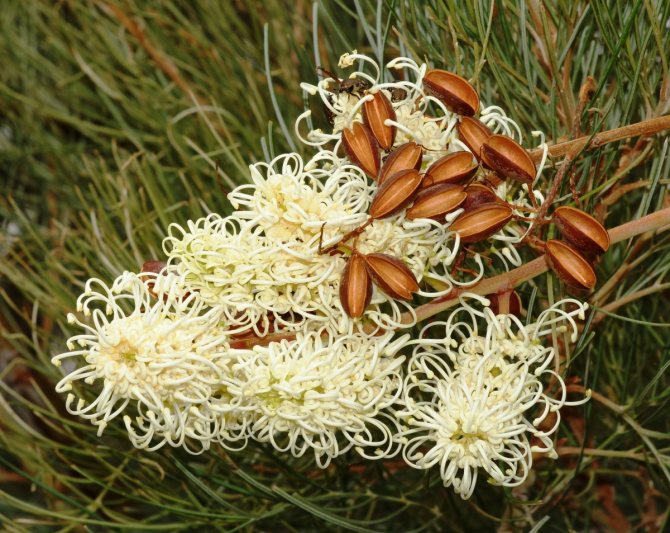

Young seedlings are placed in a well-lit room and do not allow the soil to dry out.
Pot
To germinate seeds, use shallow pots or bowls.
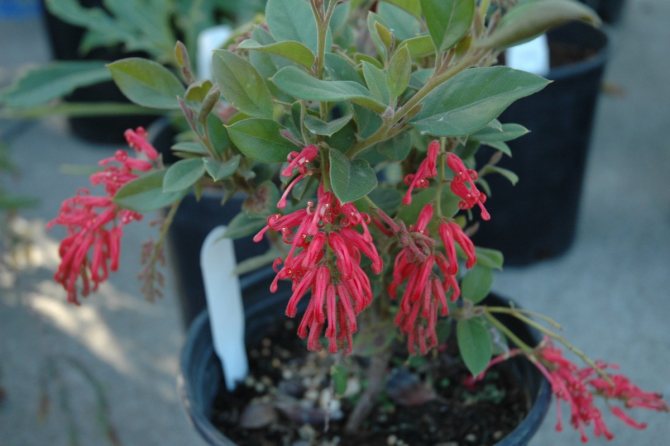

Photo:
When the young seedlings get stronger, they are planted one by one in ceramic pots with a diameter of 6-8 cm.
The soil
For planting, a special earthen mixture is prepared, which consists of one part of sod soil, one part of peat, one part of humus or leaf litter, and one part of coarse river sand. The soil solution should be slightly acidic.
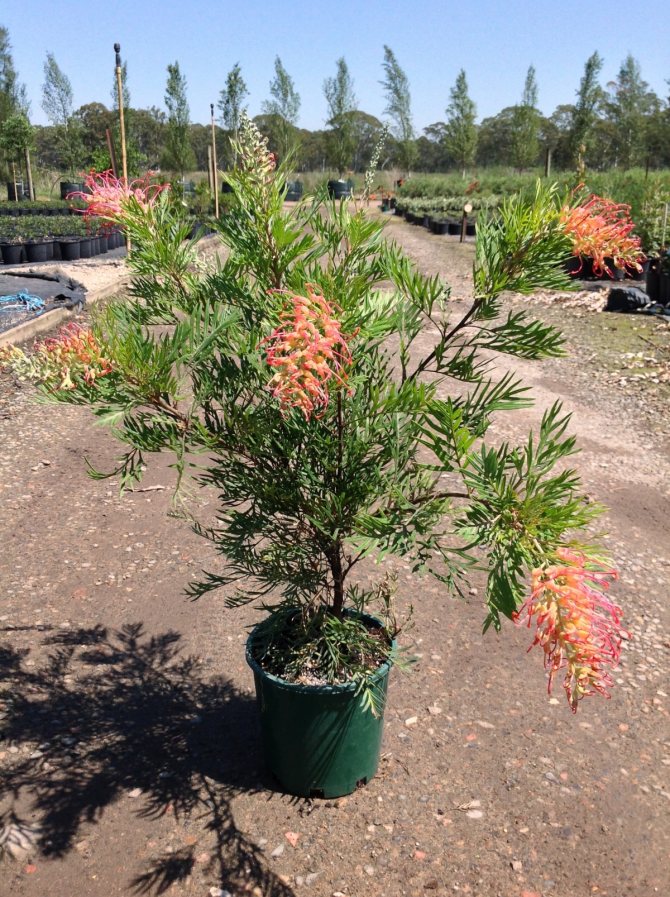

Photo:
Seedlings should be provided with ventilation, regular watering and shelter from direct sunlight.
Place in the house
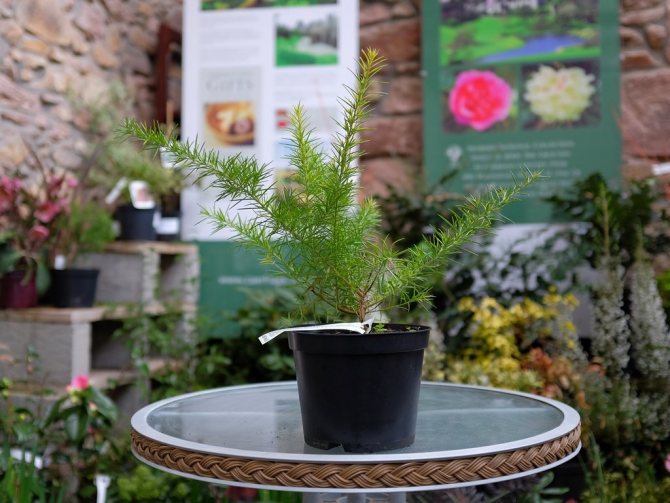

Photo: <>
For growing young seedlings, a windowsill on the south side is suitable, but at first the young plant needs protection from direct sunlight. Adult flowers are also very fond of light. When choosing a place, you need to remember that the flower does not tolerate dry air, it is not recommended to place it near heating devices. Spacious light rooms are suitable for growing.
Propagation by cuttings
Reproduction of the Grevillea plant is produced by semi-ripe cuttings in the month of August. It is best to cut cuttings from low-growing plants that do not have a branched shoot. Rooting of the plant takes place in moist sand, after which young plants are planted in pots with a diameter of 7 centimeters.
21.07.2016
Please rate the article in the rating
| (votes: 1, average: 5.00 out of 5) Loading ... | 1 comment |
← Bougainvillea flower home care pruning and reproduction Cufea flower home care pruning and reproduction →
Grevillea description
The plant of the Grevillea genus is considered to be quite large in size and directly belongs to the Protein family. It contains about 360 plant species, most of which can be found in the regions of Australia. Exceptionally 5 plant species can be found in other parts of the world, namely in New Caledonia, New Guinea, Sulawesi. The plant looks like an evergreen, creeping or erect shrub, which is most often small in size - no more than 0.5 m, but there are also varieties with rather large sizes, about 30 m high.The surface part of the cylindrical shoot is covered with a grayish and rather smooth bark. Alternate foliage is most often short-petiolate. Depending on the variety, the foliage of the plant can be of different shapes. The tubular flower can be sluggish and divisible. Despite the fact that they are small in size, they are able to form inflorescences that look like a brush of large size, since they have very long pistils.

